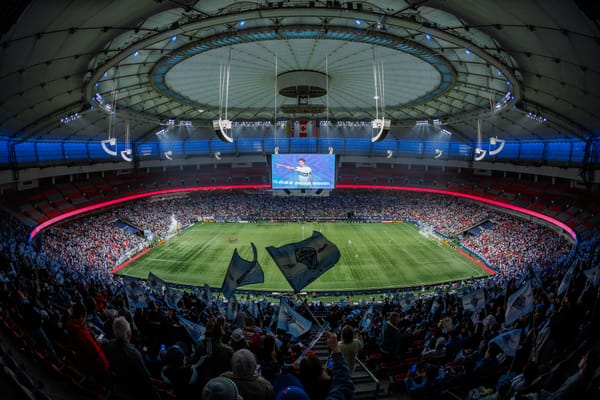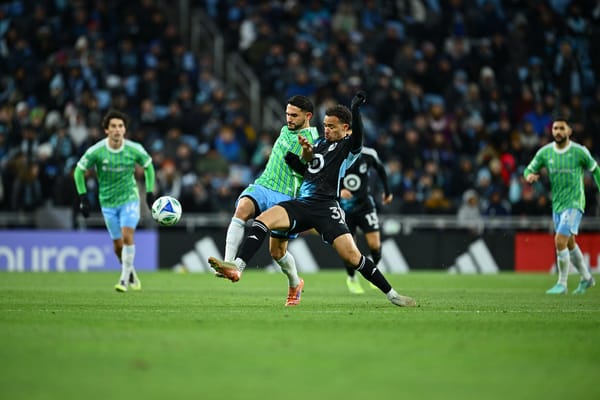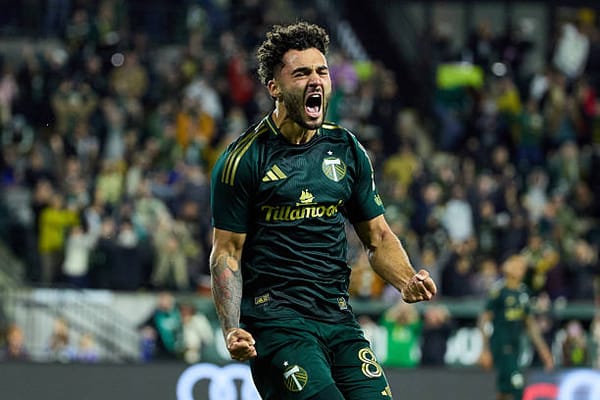The Timber Decade of Humiliation
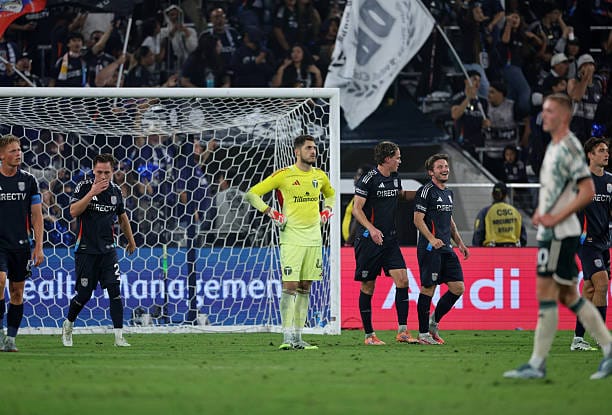
The United States of America has only existed for 249 years. A great American experiment began on July 4th, 1776. Since that landmark day in human history, the United States has grown from a loud upstart to a world power. For better and (definitely) for worse, no other country has been able to do it like the USA.
Year 250 is just around the corner, and America is not in a good place. Their status as a world power is legitimate only in terms of brand recognition. Many have referred to the 2000s as “the American century of humiliation.” In many ways, the enshittification of the United States is mind-boggling. A country that has the wealth and resources to potentially have the best quality of life in the world refuses to properly use those resources on its citizens. This is what happens when corporations have the same rights (maybe more rights) as a person.
America’s flaws are easy to see. The term “patriotism” has been perverted by, uh, perverts over recent decades. But a true patriot wants to see this country succeed. A true patriot knows that America can be the greatest country in the world, and will try their hardest to make that idea true.
Most American citizens believe in that philosophy. They might not agree on how America can be the best country in the world, but the baseline for American exceptionalism is sky high. No other country has been able to make the game of football work.
It’s a uniquely American game; taking the form of two armies marching up and down a field trying to gain territory and score points. Weekends in the fall are dominated by this game. Collegiate football (where people decide their rooting interest based on location and education) is designated for Saturdays. But on Sundays, the NFL behemoth takes center stage.
Even if you aren’t a football fan, you know the schedule. An early slate packed with games, a short afternoon slate featuring a couple major matchups, and finally a standalone game on Sunday night. Carrie Underwood comes on the TV, and she says a phrase that has worked its way into the American lexicon: “Waiting all day for Sunday night.”
The Portland Timbers fell into the Carrie Underwood boat this weekend. The schedule dictated that their massive elimination game would take place on Sunday night; 8 days after their clutch survival in Game 2. They found a way to force this crucial elimination game, which would be their biggest game since MLS Cup in 2021. Fans couldn’t wait. They needed this game to start. The anticipation was killing them. San Diego FC entered this league with the intention of taking it over. They believed that their club model was exceptional. The Portland Timbers, meanwhile, have existed for 50 years. They had history on their side; highlighted by a giant star above their crest that was earned 10 years ago. So which version of exceptionalism would prevail: the optimized club that knew exactly what they were from Day 1 or the historical club that drew their power from a history littered with upsets?
The Portland Timbers lost to San Diego FC 4-0 in Game 3. And the only exceptional thing about this game was how quickly it was over.
Recap
It took 5 minutes for San Diego to take the lead.

How does the ball get here? That answer is simple. Finn Surman tries a long throw-in down the sideline, but Manu Duah is able to win the header. Dario Zuparic heads the ball forward in response, but it falls to Luca Bombino with no one around him. One easy pass to Onni Valakari begins this move. Now we’re caught up to present day in terms of this screenshot. What happens next?
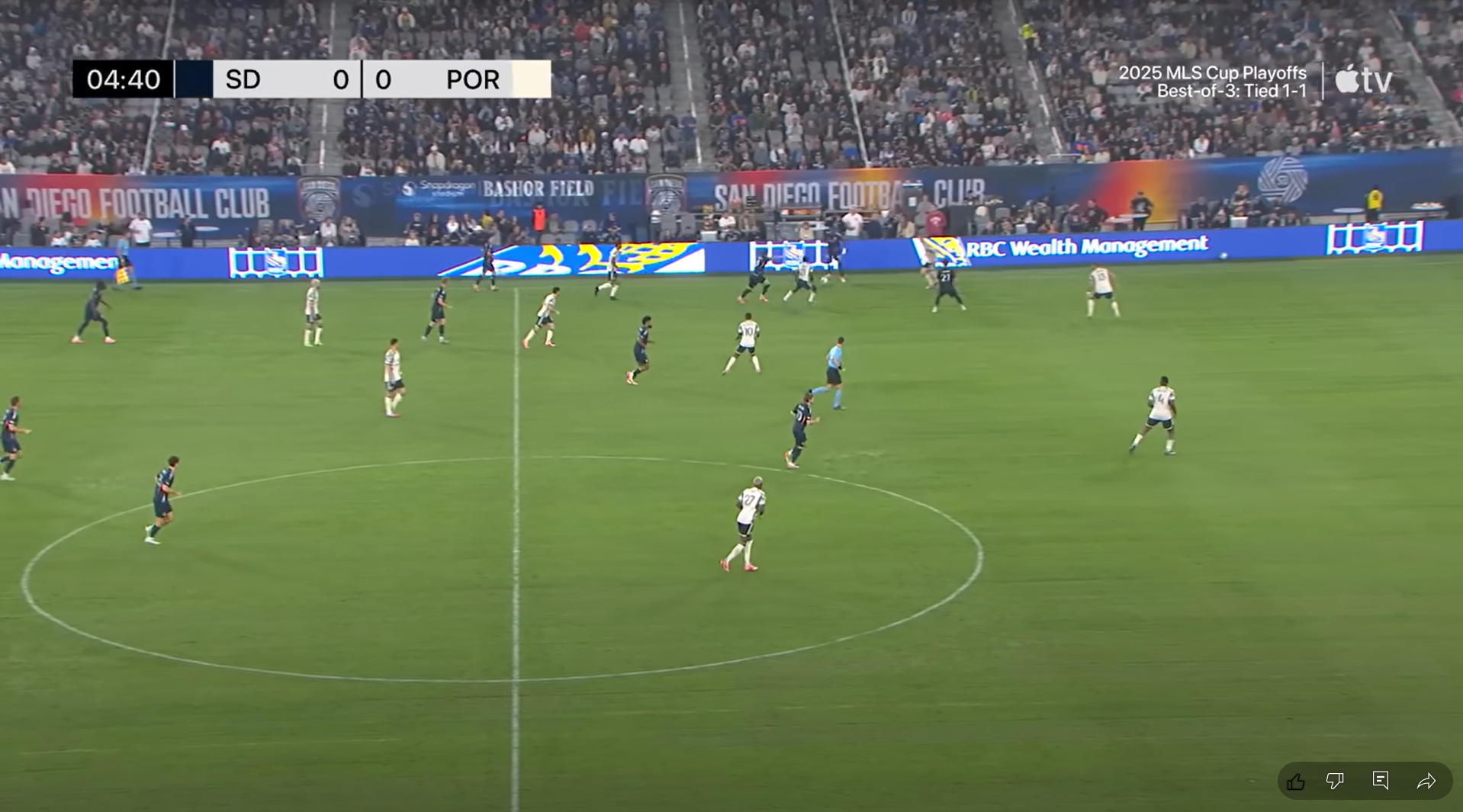
Valakari is able to carry the ball forward and find Amahl Pellegrino on the sideline. The large Finnish midfielder continues his run. He will be receiving a return pass.

Pellegrino’s return pass could be stopped by two Portland defenders. Neither Surman nor Diego Chara can cut it out. Suddenly, a clear break is on.

Dario Zuparic is caught in no-mans land, which means that the entirety of Portland’s defense has to recover in transition. This is not one of their strengths. They were unable to win the ball in midfield despite having a few opportunities to do so. Now Valakari is streaking down the left side, and he’s looking for someone in the box to receive an inevitable cross.
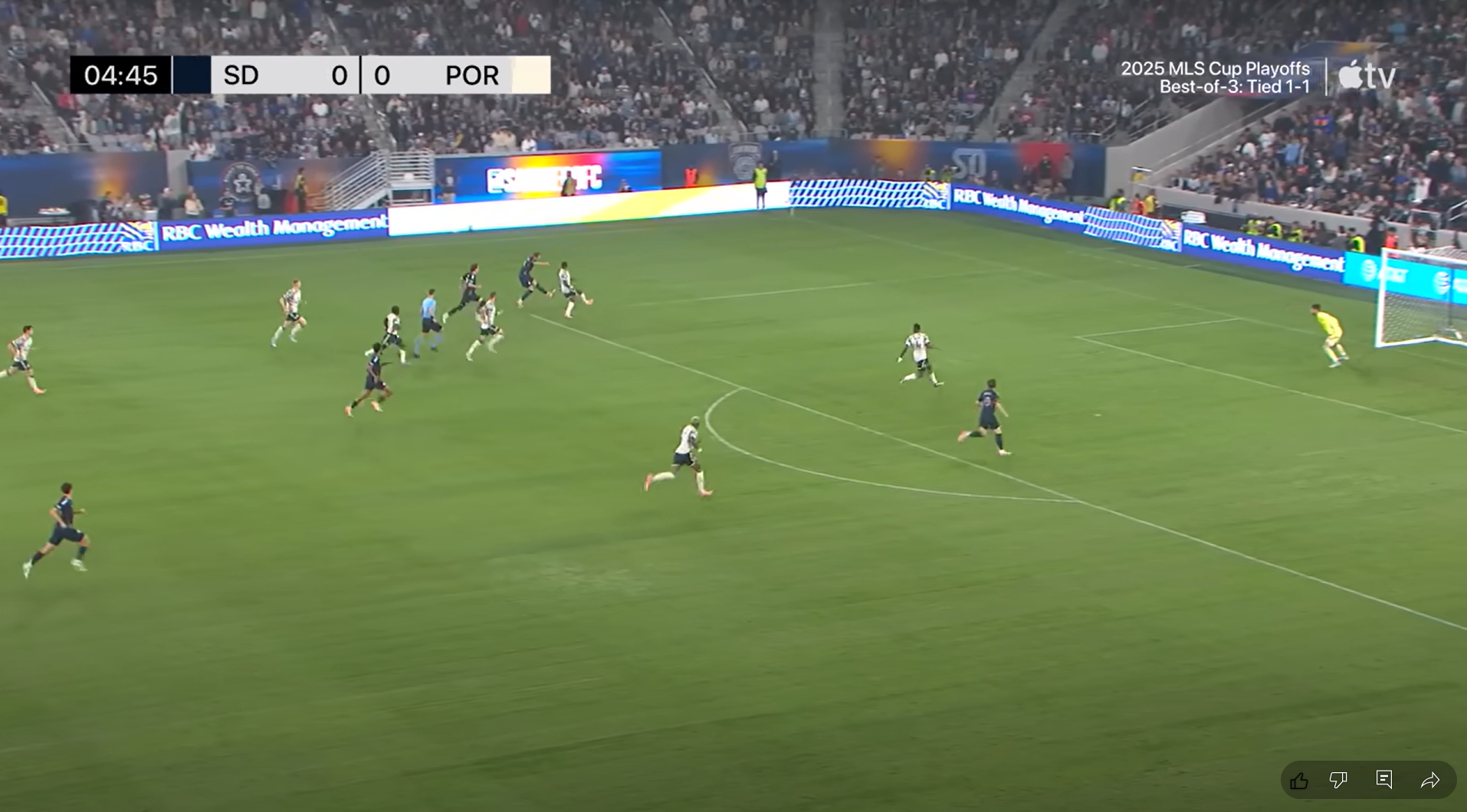
That potential recipient is Anders Dreyer. Portland has two defenders in the vicinity who can make a play on this cross. One is Kamal Miller. The Canadian center back is the only center back in the box. Jimer Fory is recovering on the far side, but he could close the gap between himself and Dreyer fast enough to beat Dreyer to the ball.

This isn’t a free volley, but it’s awfully close to one. Fory ends up being a step behind, but Miller is trying to throw a block in. Miller’s block misses, and Dreyer’s shot nestles in James Pantemis’ right corner.
Portland had to score the first goal to have any chance of winning the game outright. For five minutes, this game was (technically) even. Now their hard work to claw a goal back and get back in the game began way too early. Kevin Kelsy had their equalizing opportunity in the 11th minute.

David Ayala pressures Jeppe Tverskov and blocks his pass. Portland’s high press works. This is good.

The loose ball falls right to Kelsy. He has time to take a touch, or he could simply pass it to Kristoffer Velde on his left. But the young Venezuelan hasn’t had a look at goal like this in a while. He scored from a similar spot against the Galaxy back in April. Is it the best choice to shoot this ball at this moment? I don’t think so, but it isn’t necessarily a bad one either. He just has to get the finish down.
The shot is directly at San Diego goalkeeper Pablo Sisniega, who is able to make an easy save. It’s a blown chance, but it’s early and more chances like that could come. All they have to do is keep San Diego from scoring another goal. A two-goal lead is practically a death sentence. You’ll never guess what happened next.
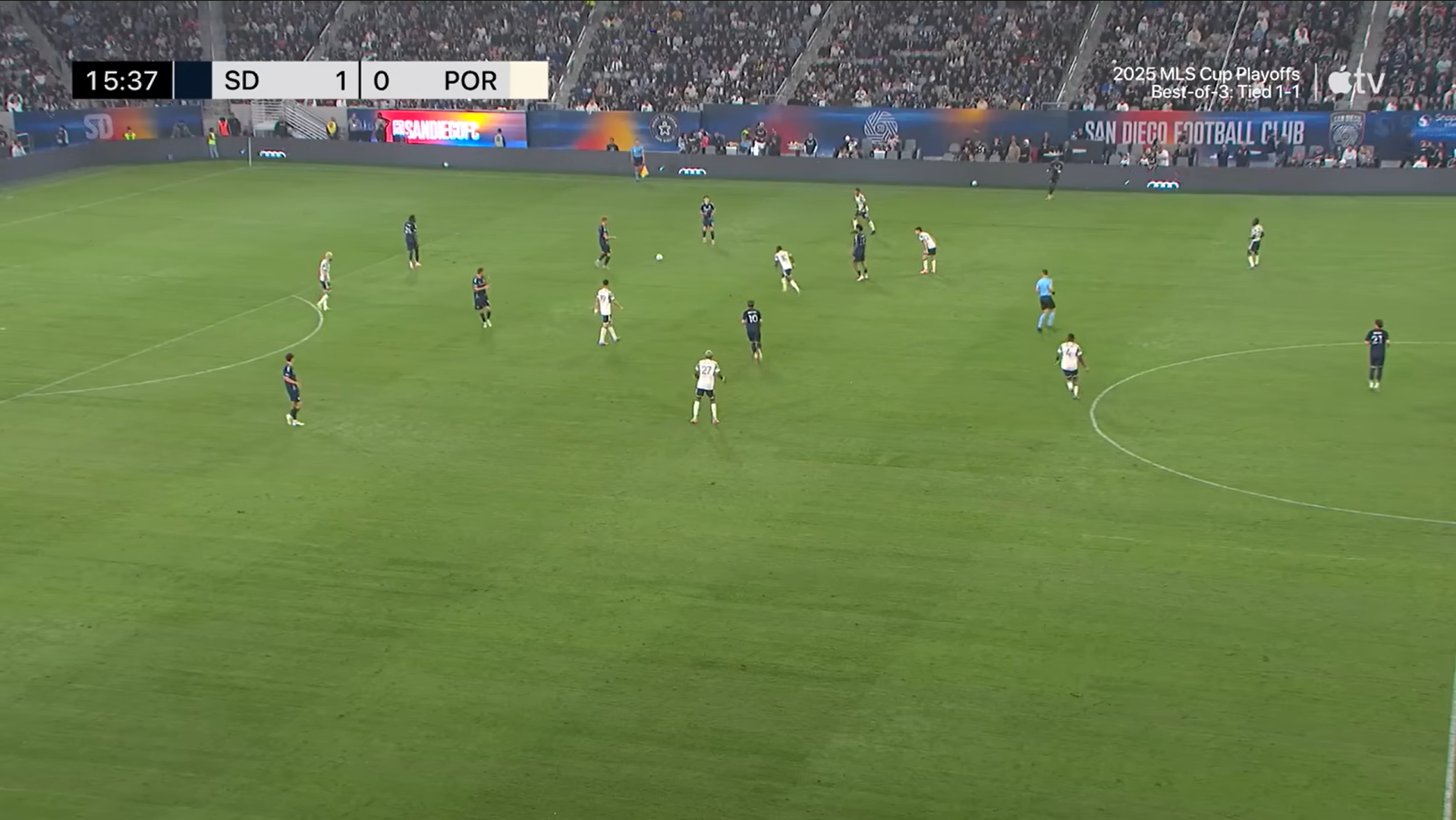
This was not the same Portland press from Game 2. More on that later. Jeppe Tverskov is about to receive the ball with minimal pressure. In football (the American one), pressuring the quarterback is essential. You can’t be a good team without a quality pass rush. Here’s the pass rush that Portland brought to Game 3. It’s objectively bad.
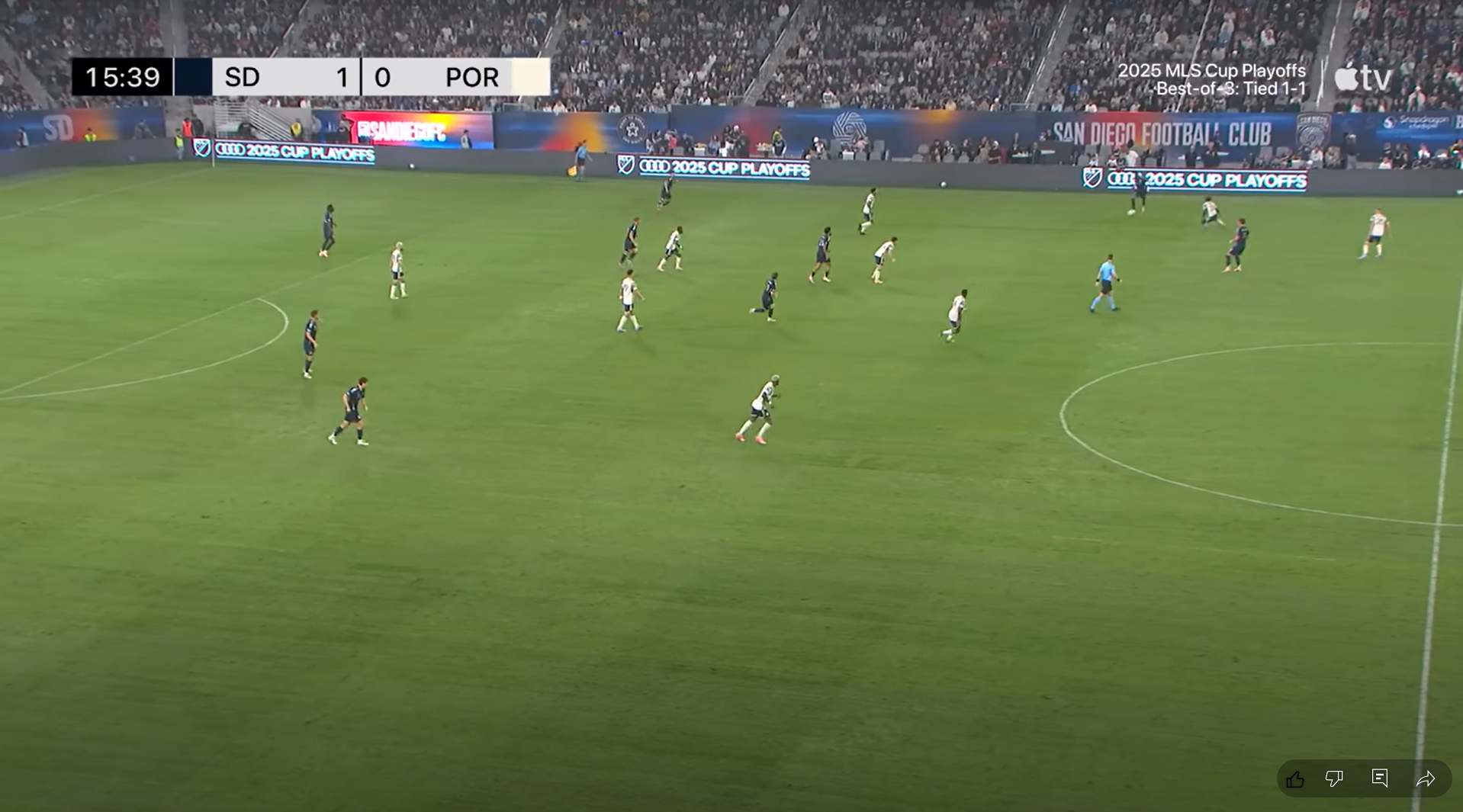
The Danish quarterback is able to bypass FIVE Portland defenders with a single pass. That’s objectively bad.
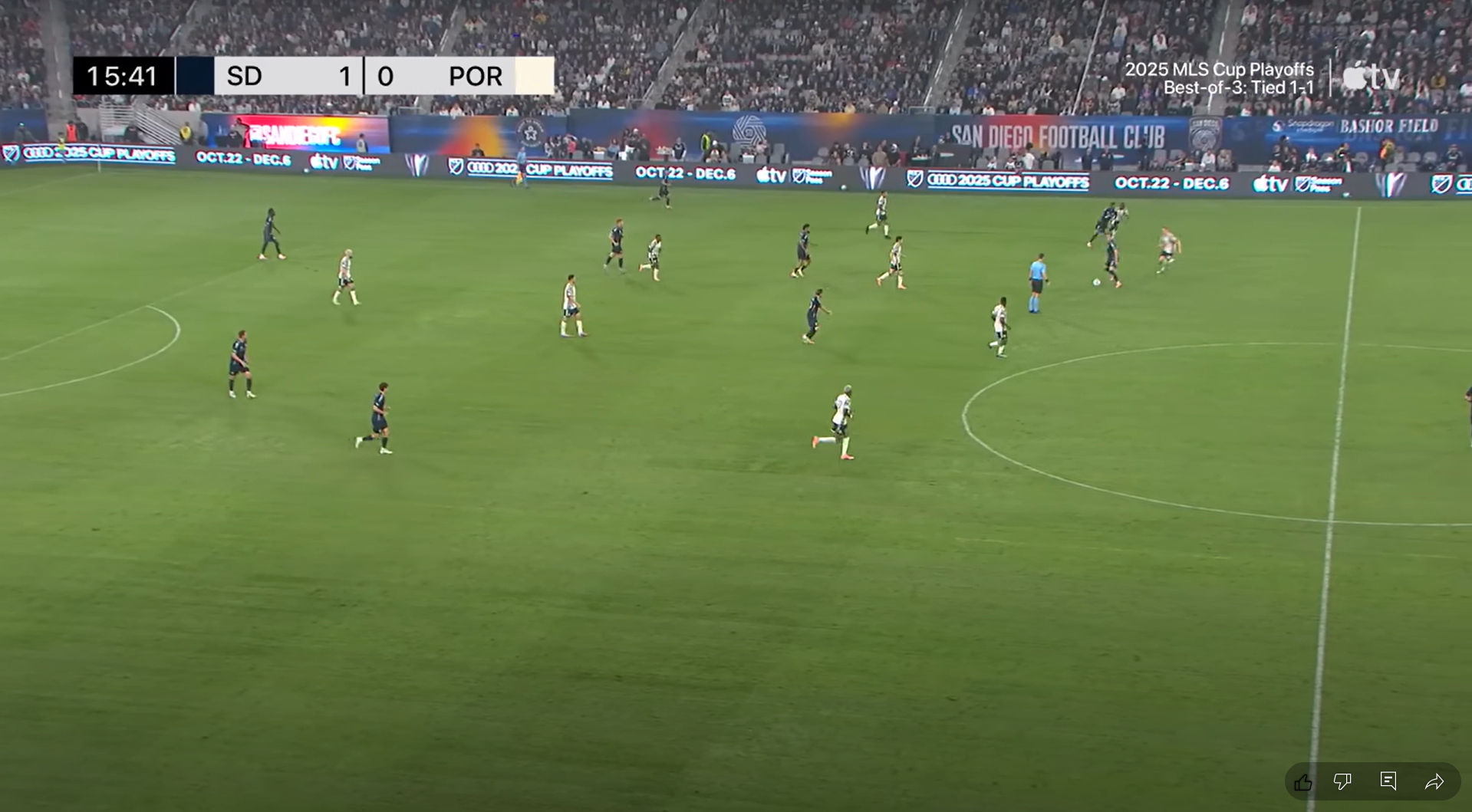
Pellegrino quickly moves the ball to Valakari. San Diego is in complete control, and they know exactly what they want to do.

Valakari goes back to Dreyer, and the deep ball is open. Pellegrino has left Chara in the dust, and Portland’s exposed backline is about to get ripped to shreds. Technically, it already has been.
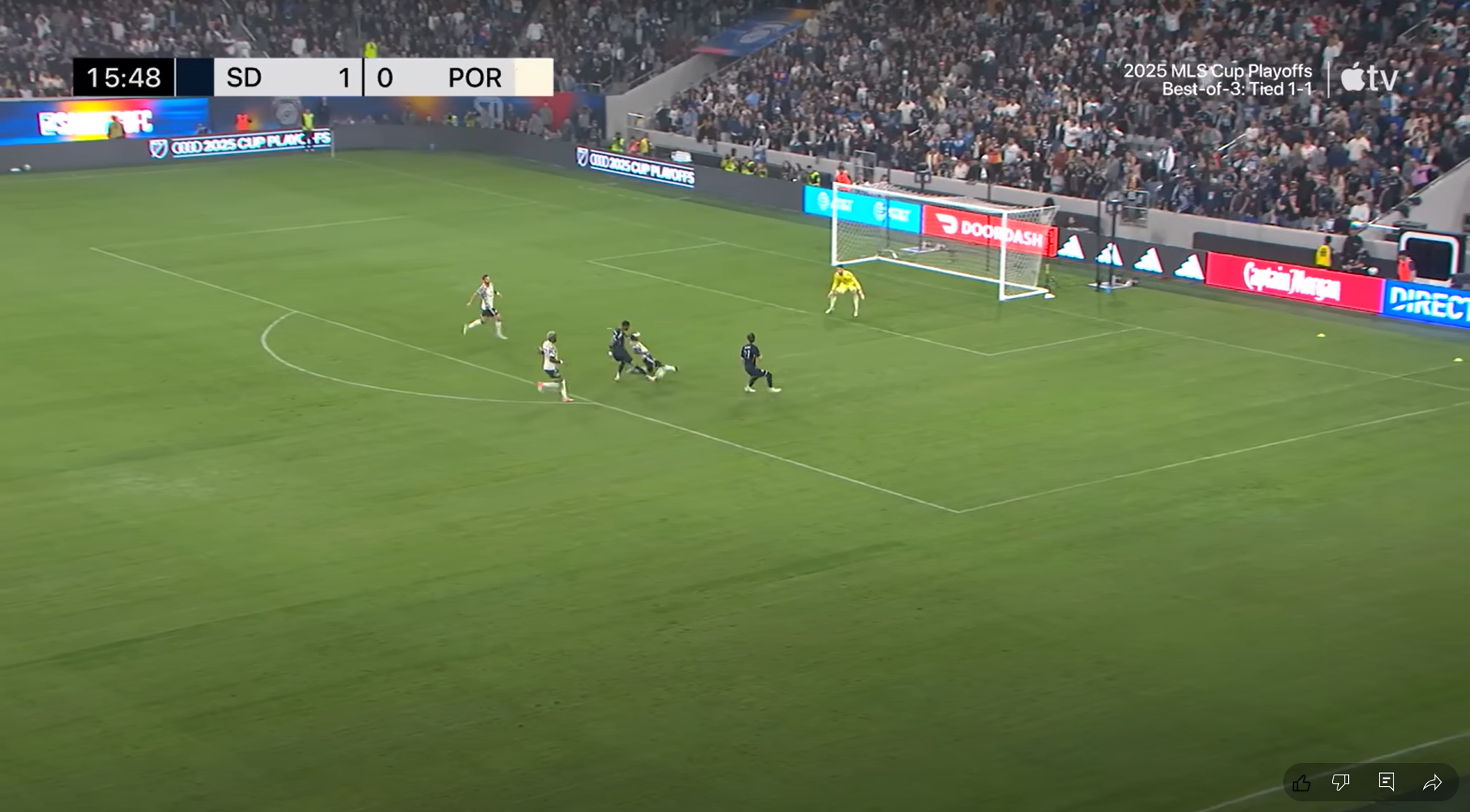
Chara is able to catch up to the Norwegian winger. He slides in to block Pellegrino’s shot.

Pantemis catches the shot. Crisis averted, for now. A quick roll to Chara follows before the club captain launches the ball into space for Antony on the right wing.

Antony tries to find Velde, but Bombino turns the pass into a 50/50. He wins the 50/50. San Diego has the ball again.

They opt to slow it down. Several more (unpressured) passes are completed before Valakari tries to go over the top to Corey Baird. That pass is easily intercepted by Chara.

Baird comes up behind him and takes the ball. San Diego has possession again.

The ball gets worked back to Sisniega. In theory, every Portland player has a man to mark. But the most important player on the pitch (Dreyer) has no one around him.
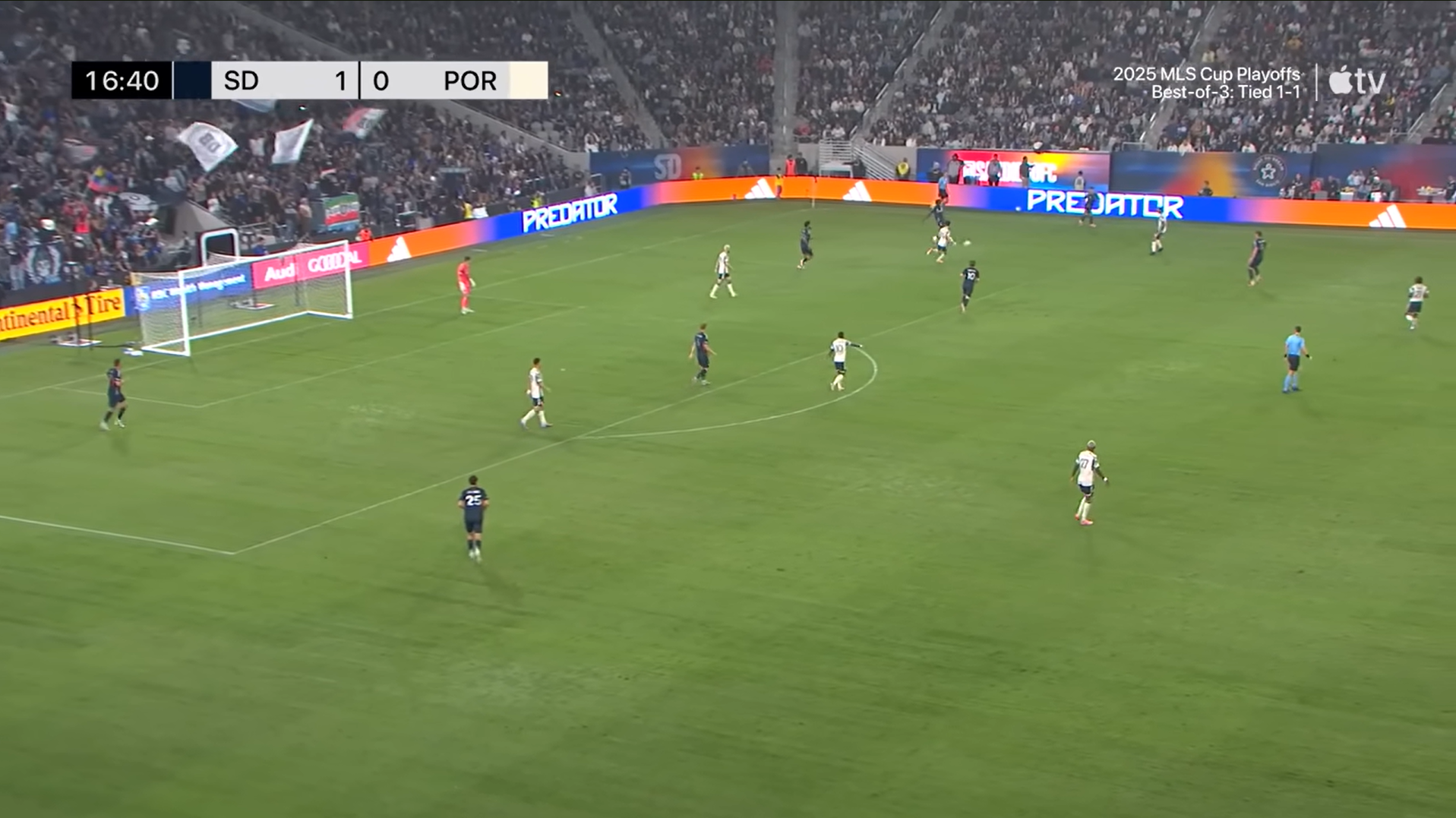
I wonder how many Portland players are about to get bypassed. Duah has the ball, and his first passing option is wide open.

That ball hasn’t even traveled 10 yards, and 5 Timbers are now behind it.
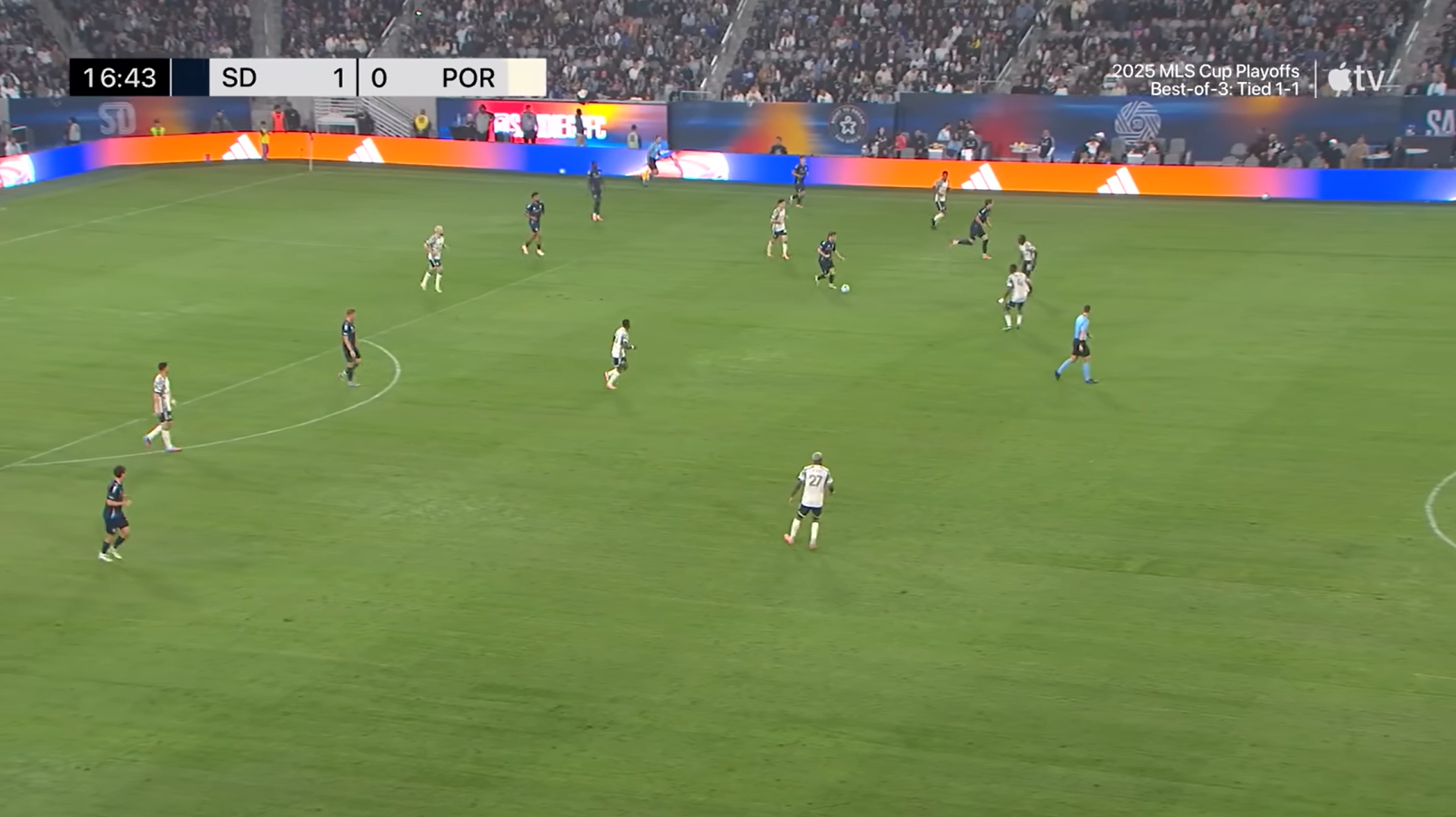
Dreyer has an ungodly amount of time and space. He’s facing Chara and Miller. Valakari begins to make a run at the top of the screen. No one goes with him.
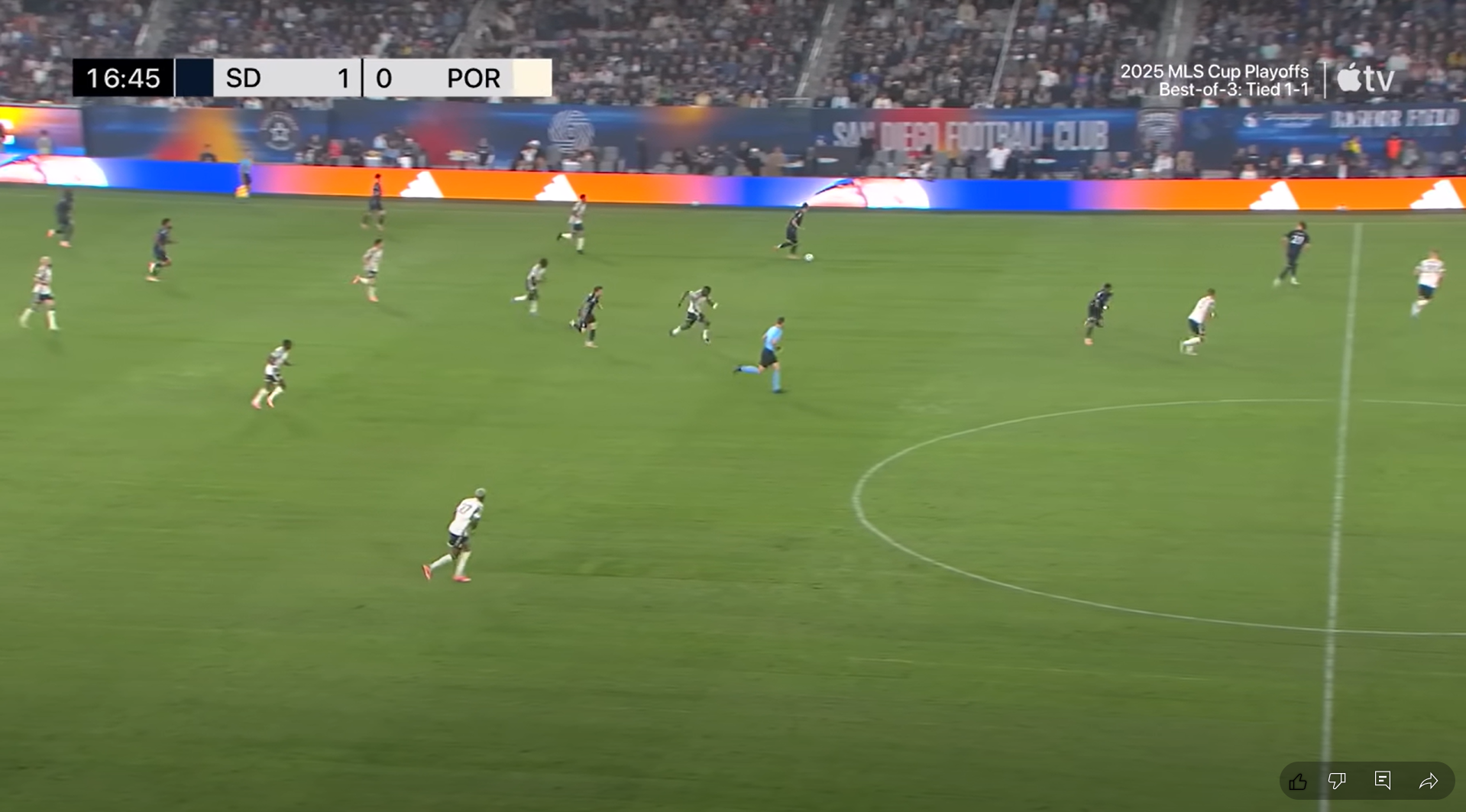
Now it’s a 3v2. Miller is trying to recover, but Valakari has endless time and space to carry the ball from the edge of Portland’s attacking third to Portland’s box.
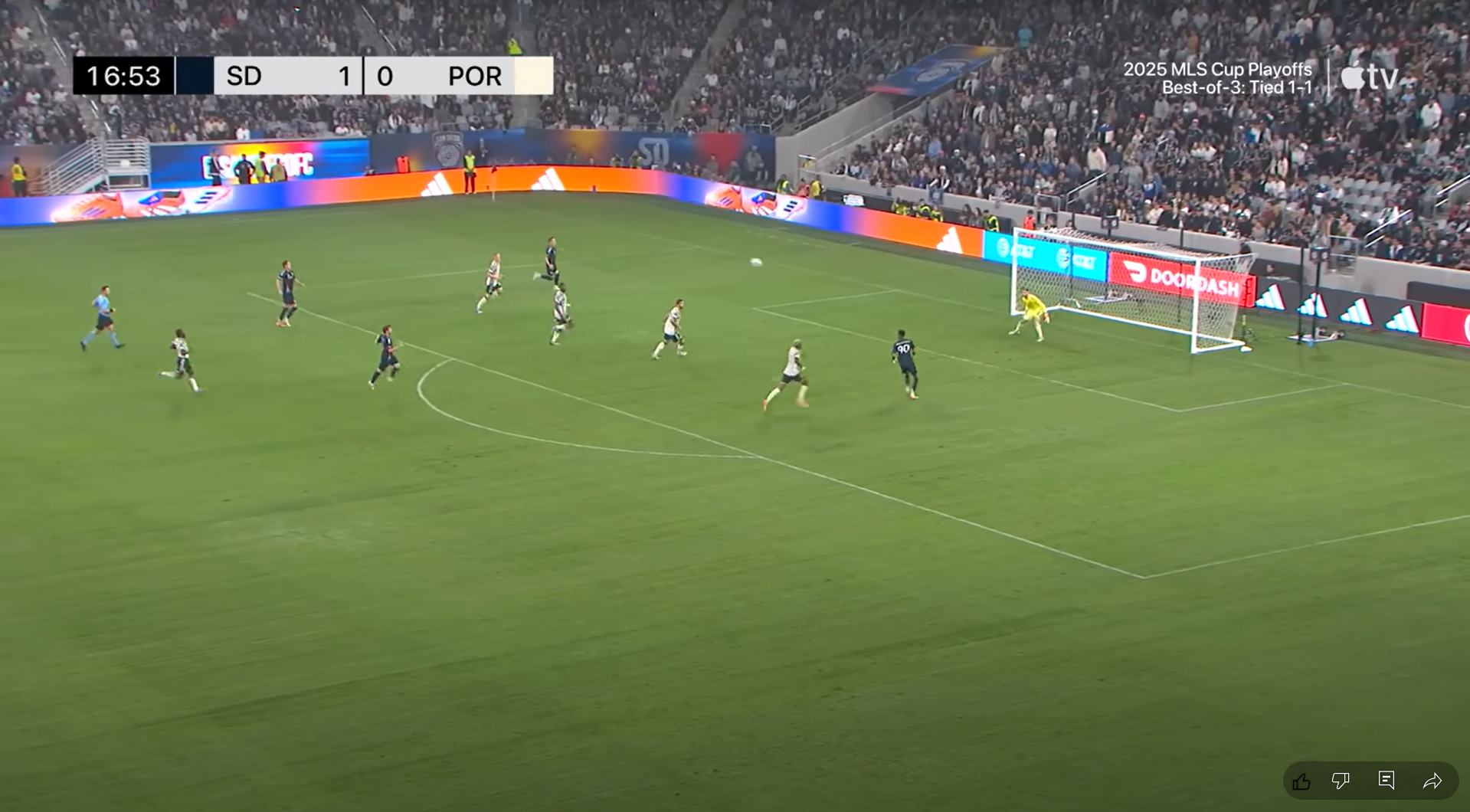
This is a very nice cross. It’s easy to cross the ball like that when there’s no pressure. Pellegrino goes to the back post. Fory is unable to recover in time to make a play on the ball.
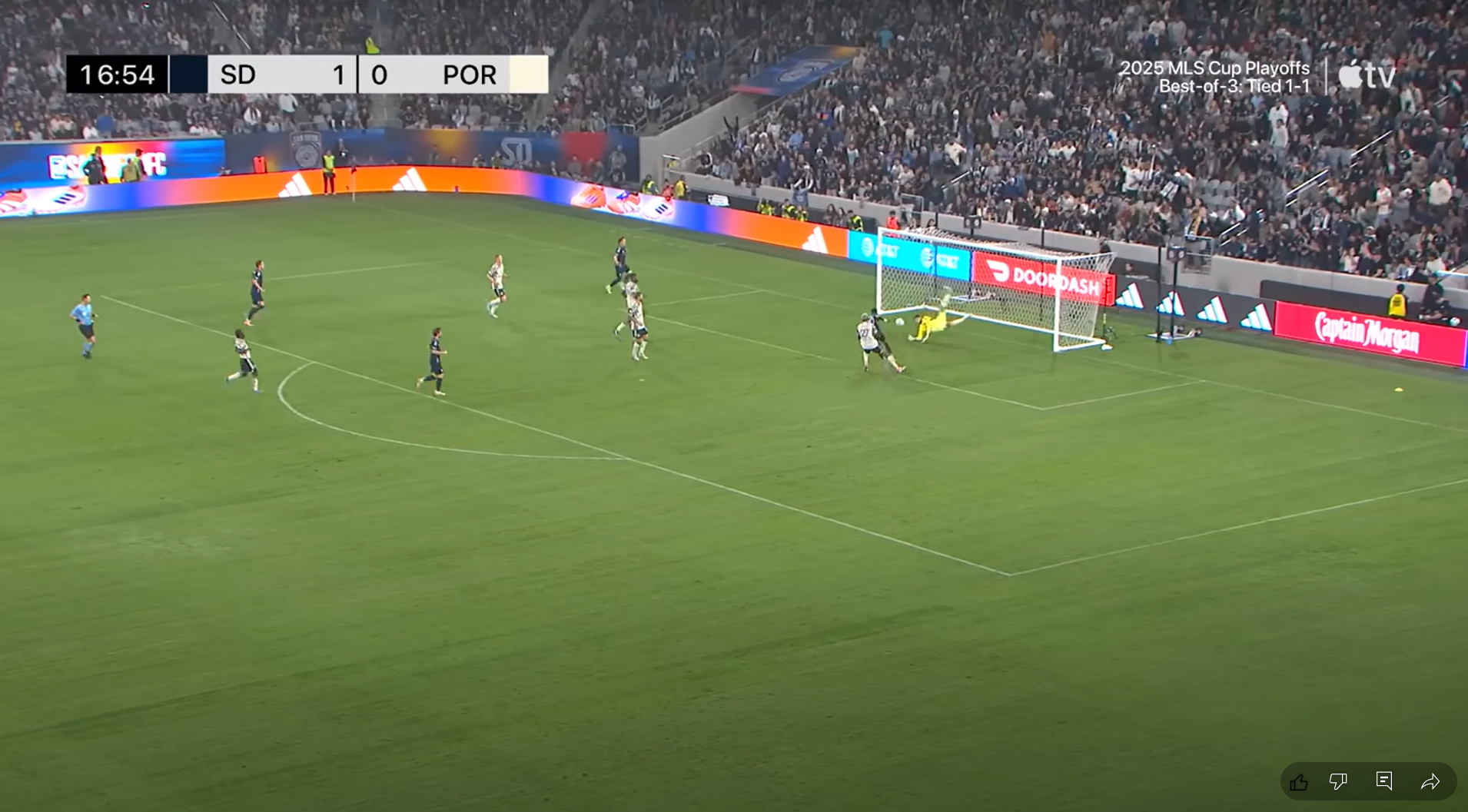
Pantemis to the rescue again. Well, technically a brief rescue.

Pellegrino follows the rebound. Goal. 2-0. 17th minute.
Now the game is extremely over. However, the Timbers gave themselves a fighting chance in Game 1 by scoring a goal before halftime. In the 27th minute, Portland had two opportunities to get that goal. Both came courtesy of Antony crosses into the box. The first was headed over the goal by Kelsy, but the second was further confirmation that it just wasn’t going to be Portland’s night.
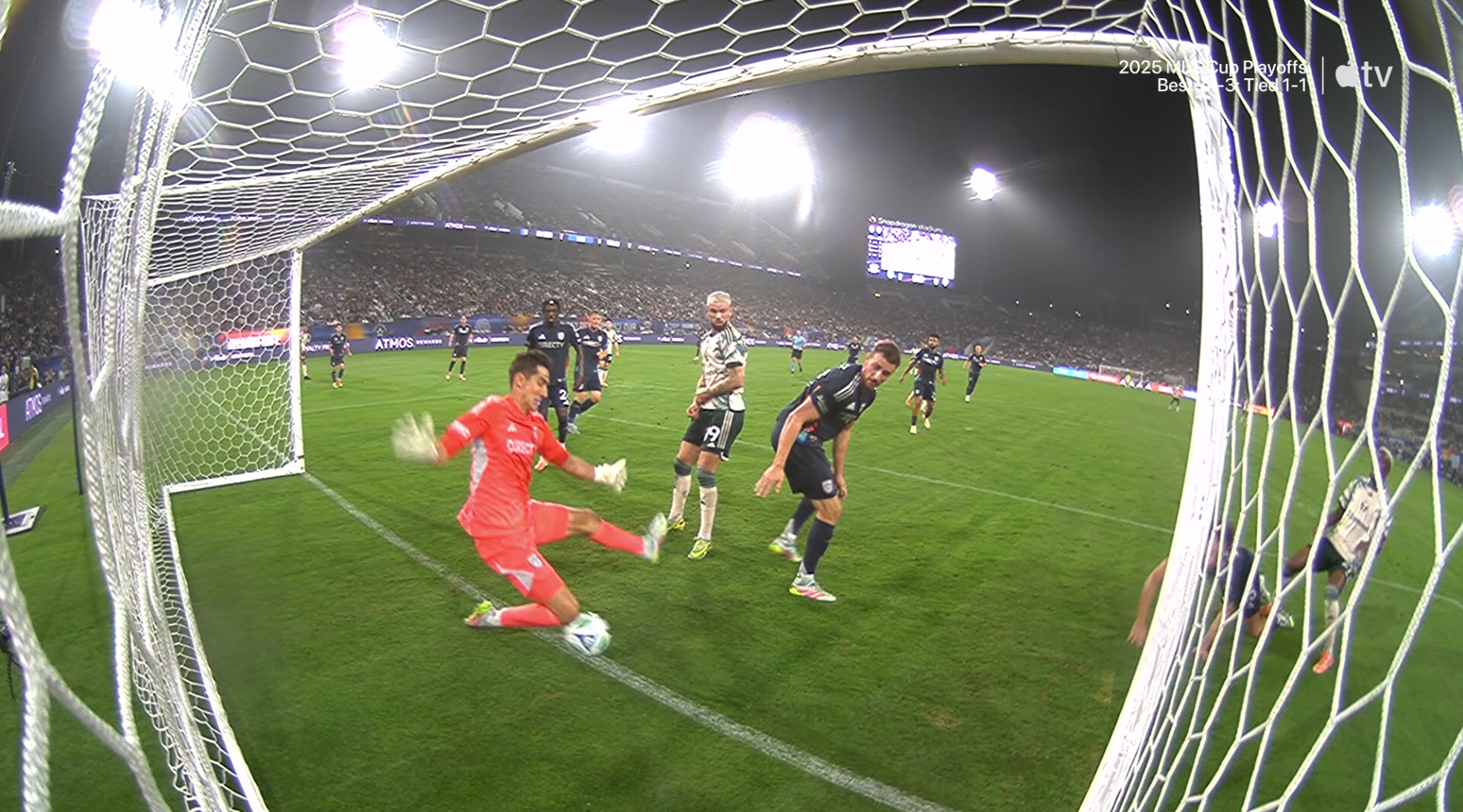
The cross finds Fory at the back post, but his header deflects off McVey. Sisniega is falling backwards, but his knee keeps the ball from crossing the line. Rough.
Another Portland chance came on a 40th-minute corner kick. Velde’s delivery to the far post was headed back into the middle of the box by Zuparic. Kelsy tries to make a play on it, but he gets it wrong. It goes from Kelsy’s head to Fory’s, and it easily floats into Sisniega’s arms. In first-half stoppage time (minute 45+2 to be exact) Fory sent a good cross into the box for Kelsy, but it was headed wide from a tough angle.
The Timbers entered halftime down 2-0. They had chances to pull a goal back, but they were fundamentally broken without the ball. Here’s a quick stat. Portland and San Diego have played each other 4 times over the past month. Up to this point (halftime of Game 3) Los Plasticos scored 10 goals in those 4 games. 3 were scored within the first 15 minutes of the second half. You’ll never guess what happened in the 53rd minute of tonight’s game.
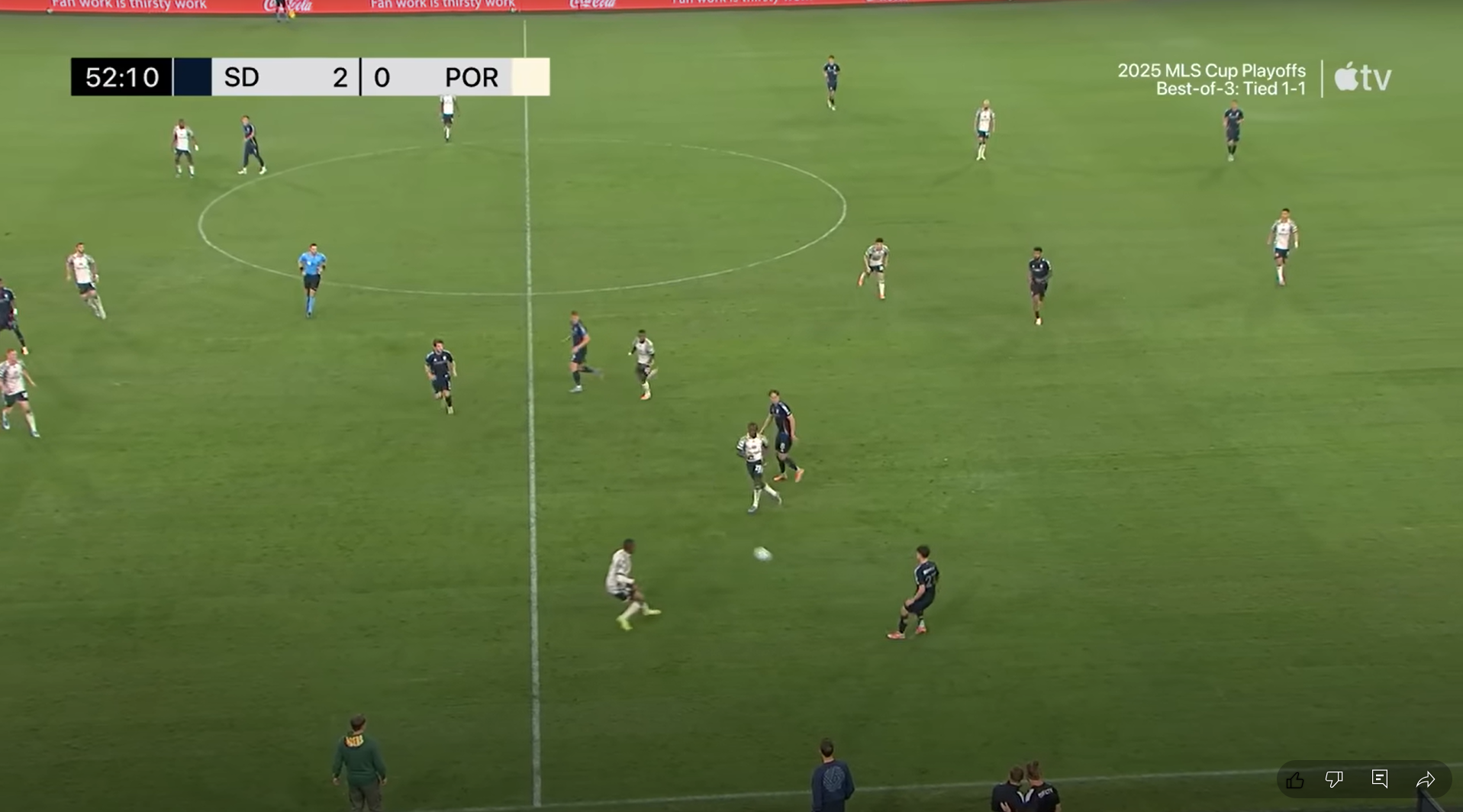
Bombino begins the play by finding Dreyer, who is once again unmarked.
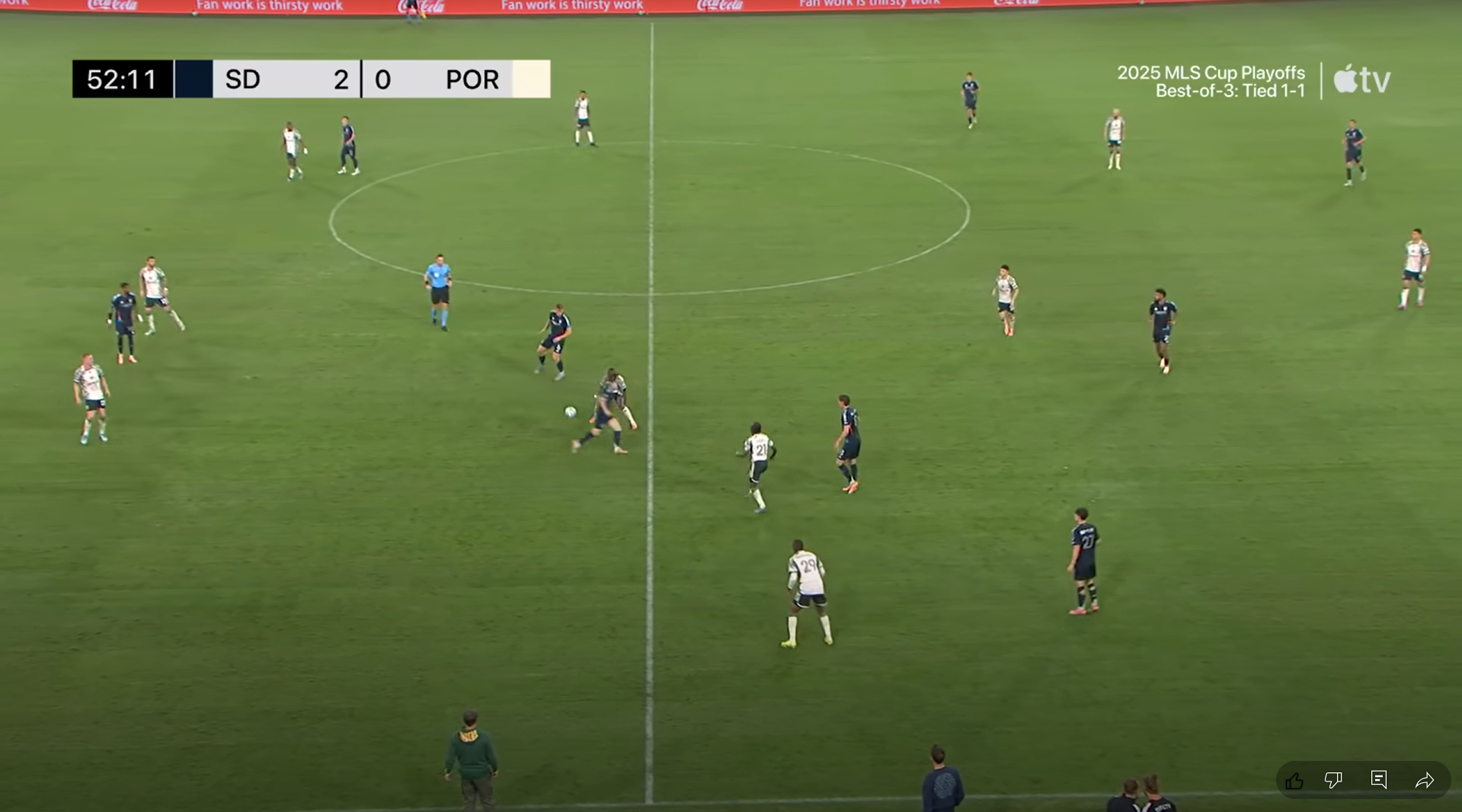
David Da Costa arrives to pressure, but Dreyer simply dummies the ball for Tverskov, who has appeared behind him and is also unmarked.

Sigh.
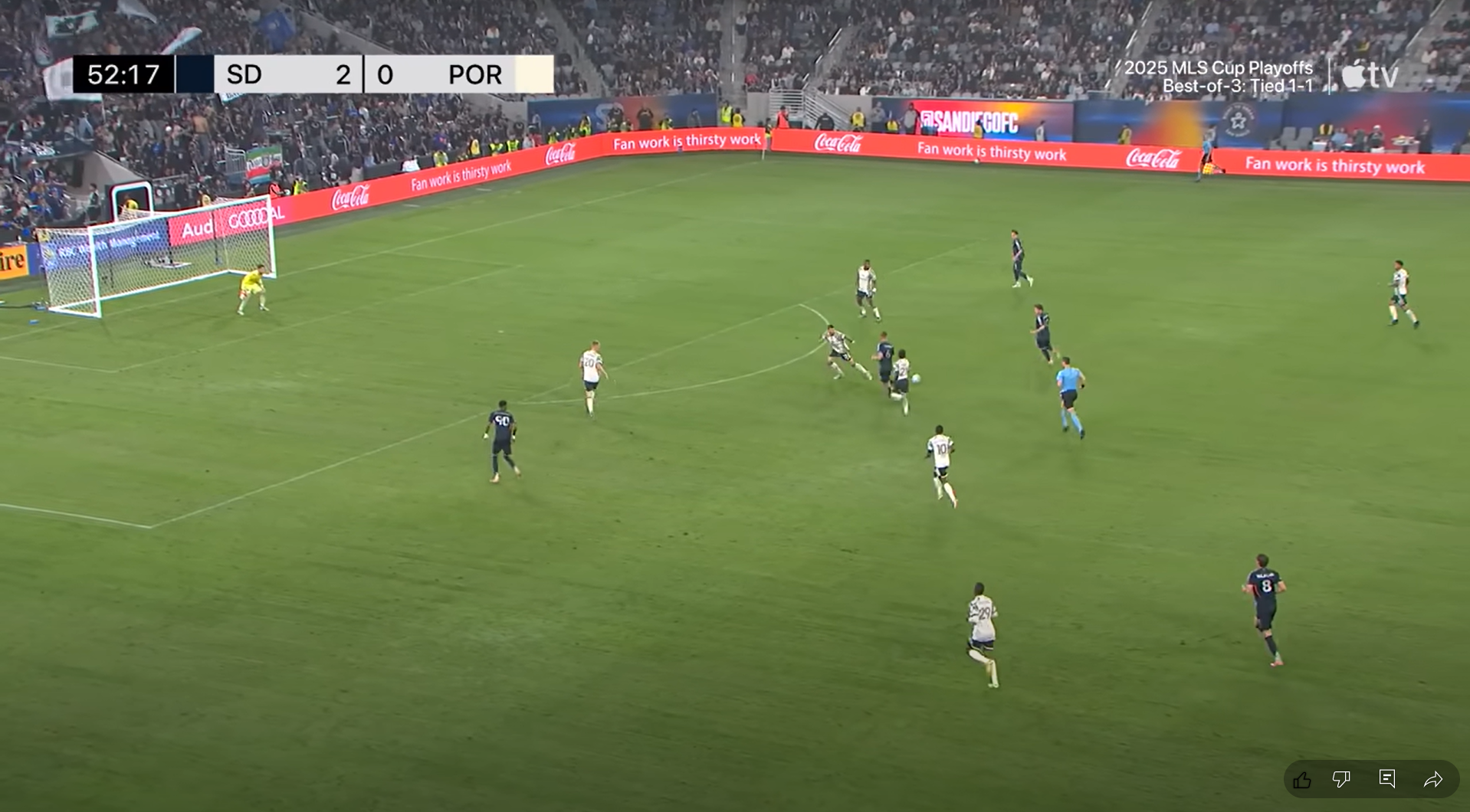
Dreyer has continued his supporting run, and he now receives the ball on the edge of the 18. But I’d like to draw your attention to both of the previous screenshots. Pellegrino has moved closer to the box. Juan Mosquera hasn’t closed the distance between himself and Pellegrino. That’s an important fact that will become important later.
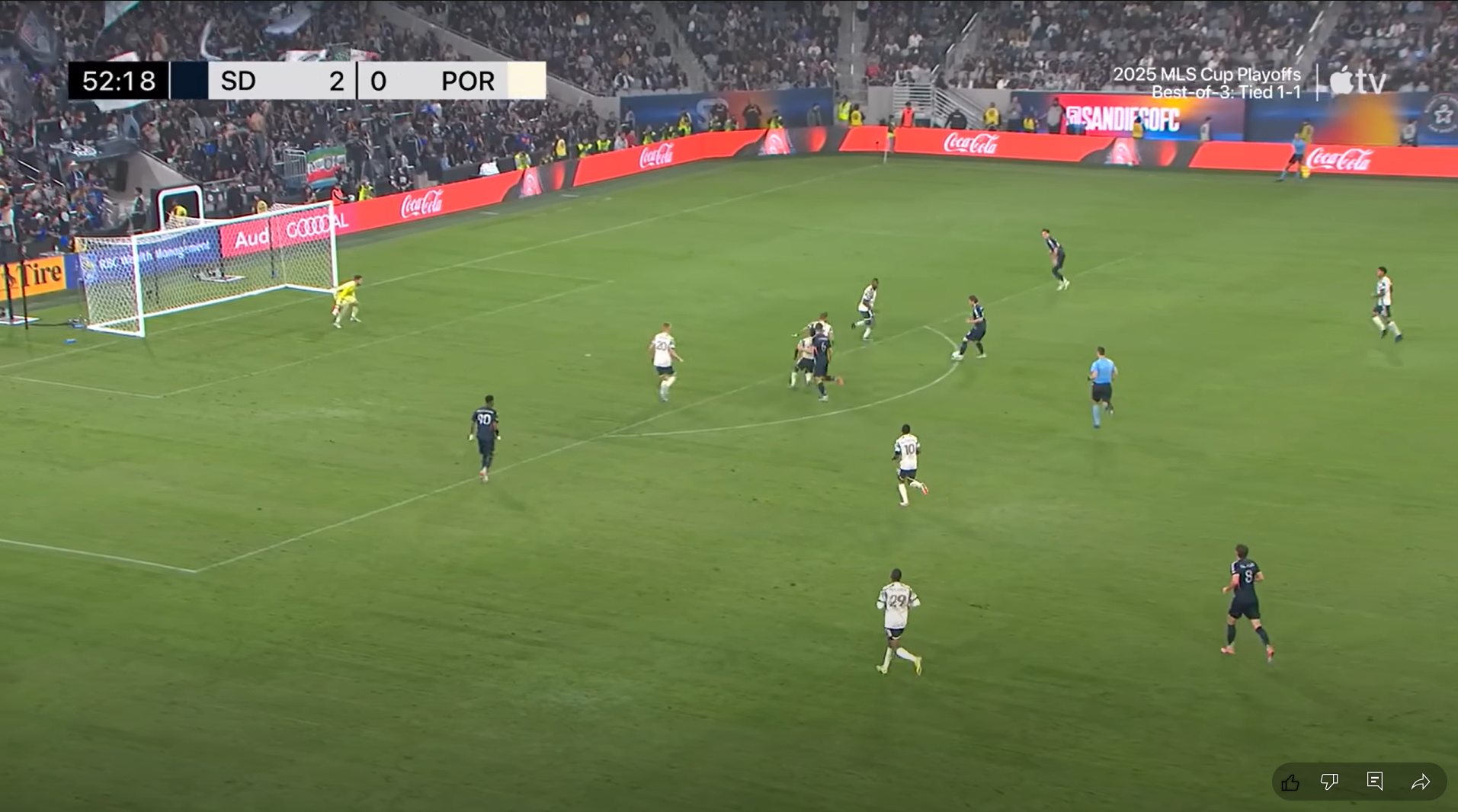
Corey Baird can receive the ball on the right side of the box in space as a treat. After all, it is a playoff game. No need to be selfish. Man, that’s a really large gap between Pellegrino and Mosquera.
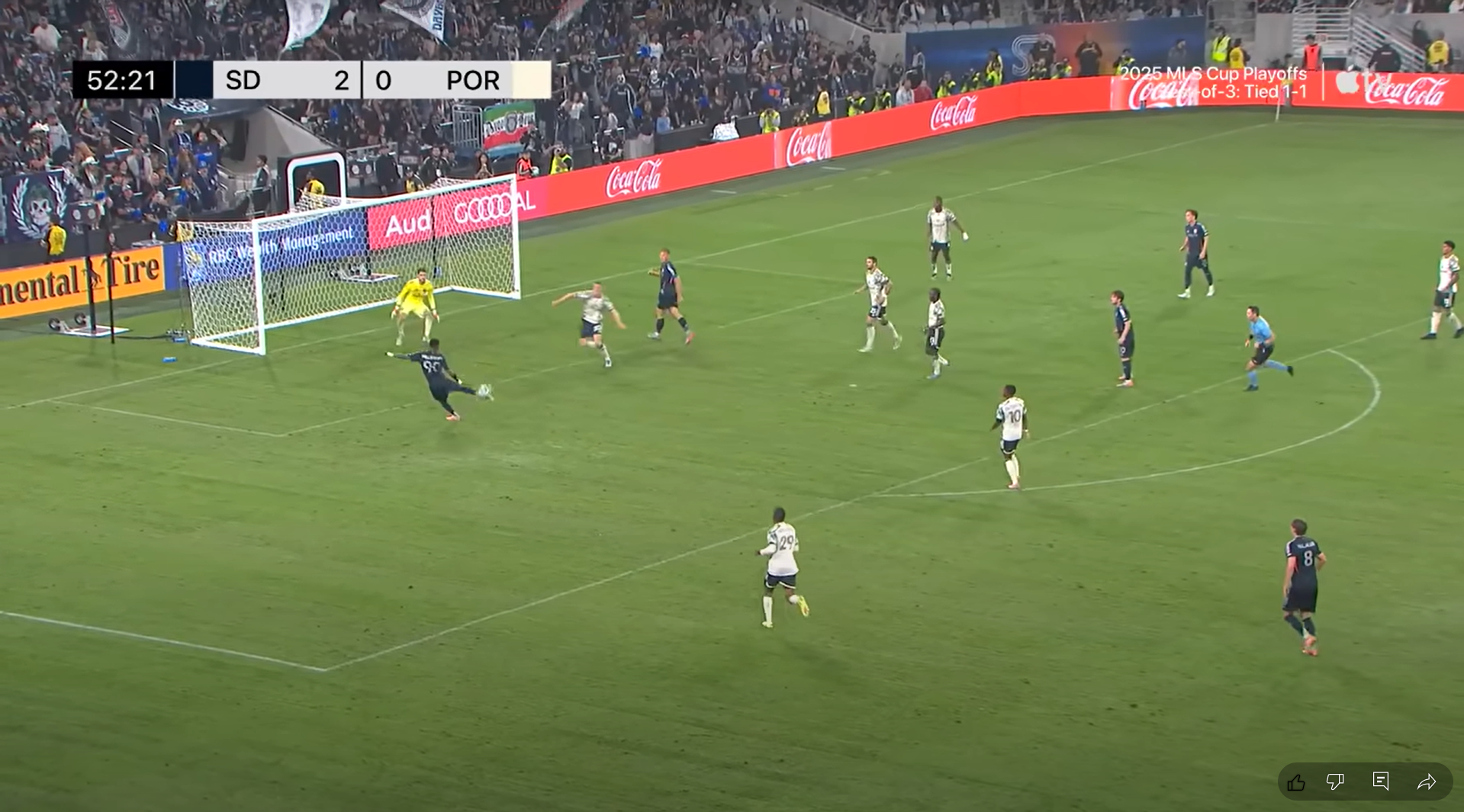
At what point do you start laughing? When does this become so terrible that you can only laugh at it? Was it after the first goal? Maybe Kelsy’s missed chance in the 11th minute? How about the second goal? For me, it was this one. No San Diego player during this sequence actually runs besides Dreyer. Pellegrino is able to jog to the back post and gets rewarded with a wide-open chance.
The humiliation has fully set in. As the nation of America continues to fall, the Portland Timbers have officially added another chapter in a decade of full of embarrassing moments. Technically it’s a blowout loss at the hands of a superior opponent. But after such an emotional Game 2, and the possibility of carrying tangible momentum into Game 3, they once again found the worst way to lose.
The rest of this game is garbage time. For the fourth year in a row, Portland’s final game of the season has entered garbage time within minutes of the beginning of the second half. At this point, it’s a feeling everyone is familiar with. San Diego just had to keep the ball (something they’re very good at) and run out the clock. But they had a story to tell, and that tale needed a fourth goal.
Do I need to do the screenshots for goal number four? Probably not, but I’m gonna do it anyway.

How does the ball get here? A quick throw-in to Tverskov and a long ball down the wing. Marcus Ingvartsen is able to get to the ball ahead of Zuparic.
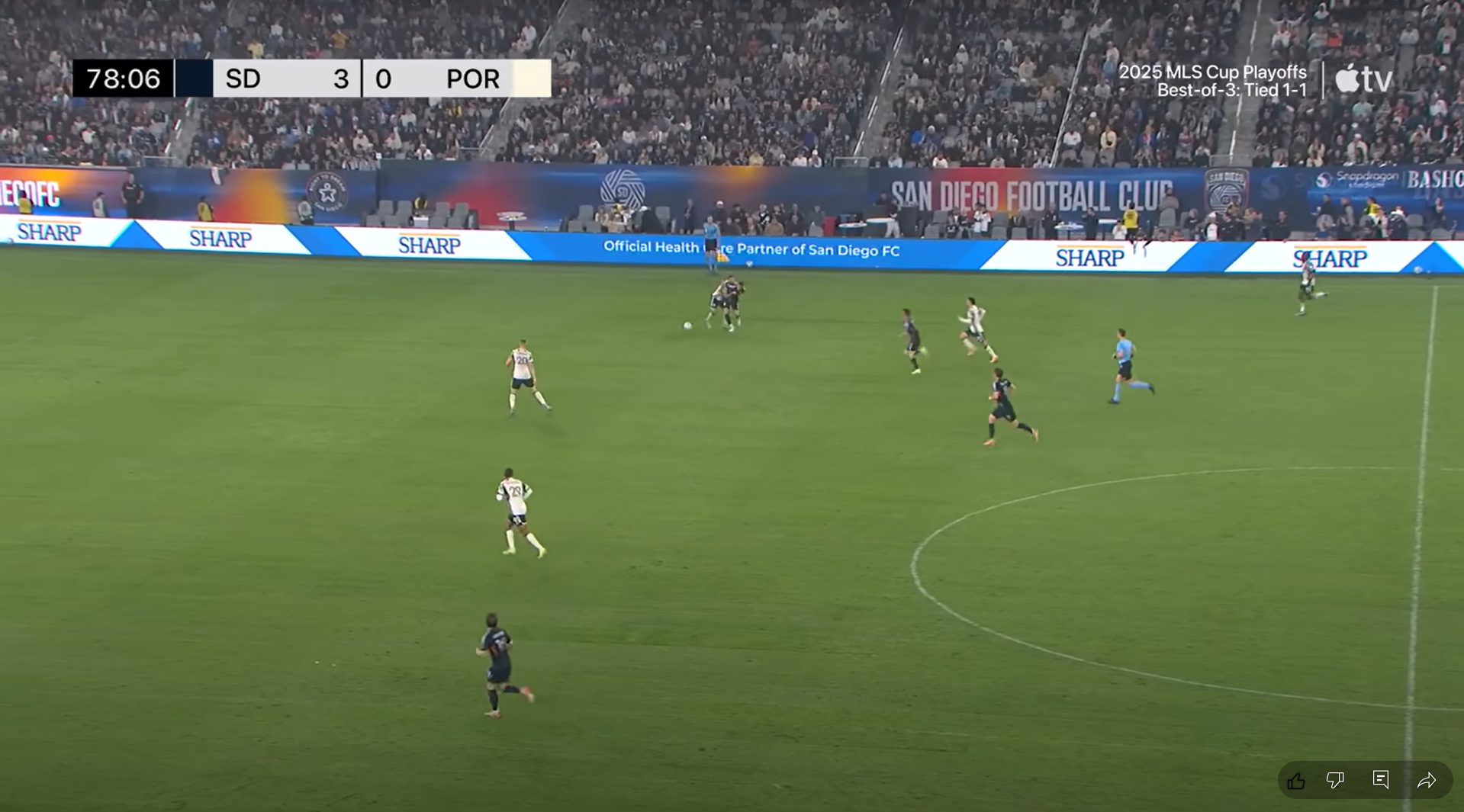
The striker and the center back get tangled up, so the ball becomes loose. Hirving Lozano is making a run from midfield to get to the loose ball. He’s gonna catch up to it. Simply making a hard-driving forward run from a deep position can create a chance.
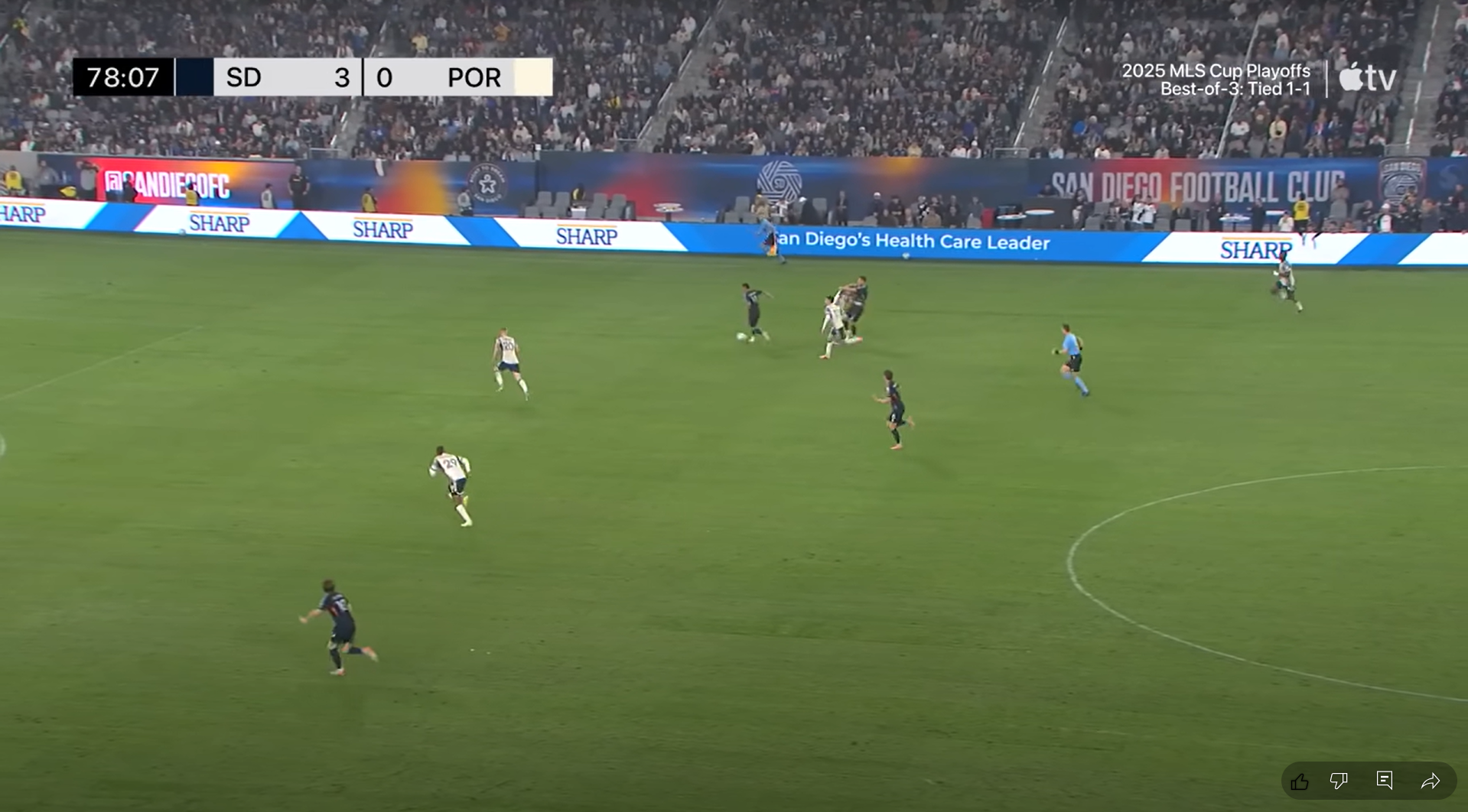
Here’s where Lozano collects the ball. It’s already a 3v2.
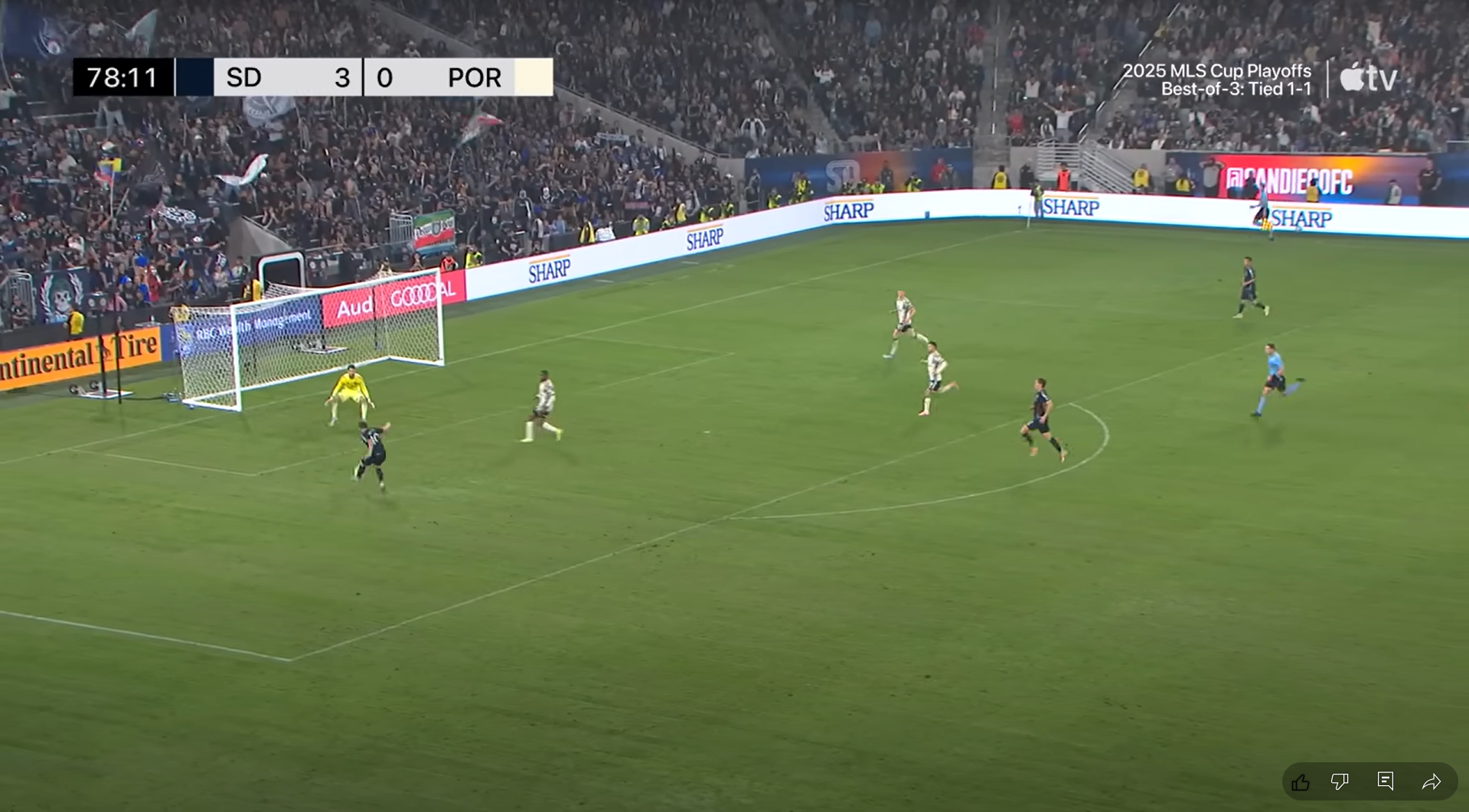
A ground cross through the box to Dreyer at the far post. This is the final goal the Timbers would concede in this game. All four came at the far post. The first two were challenged, with errors further up the pitch compounding their inability to stop the attack. But the last two were completely gifted.
Last year, I wrote about Portland’s continued failures to properly defend the far post. I’ll get into it more later. Every single San Diego goal was avoidable. So was the final notable action of this humiliation.
In the 80th minute, Lozano made a hard foul on Mosquera in the middle of the field. Referee Joe Dickerson immediately blew the whistle. Then Mosquera decides to retaliate.
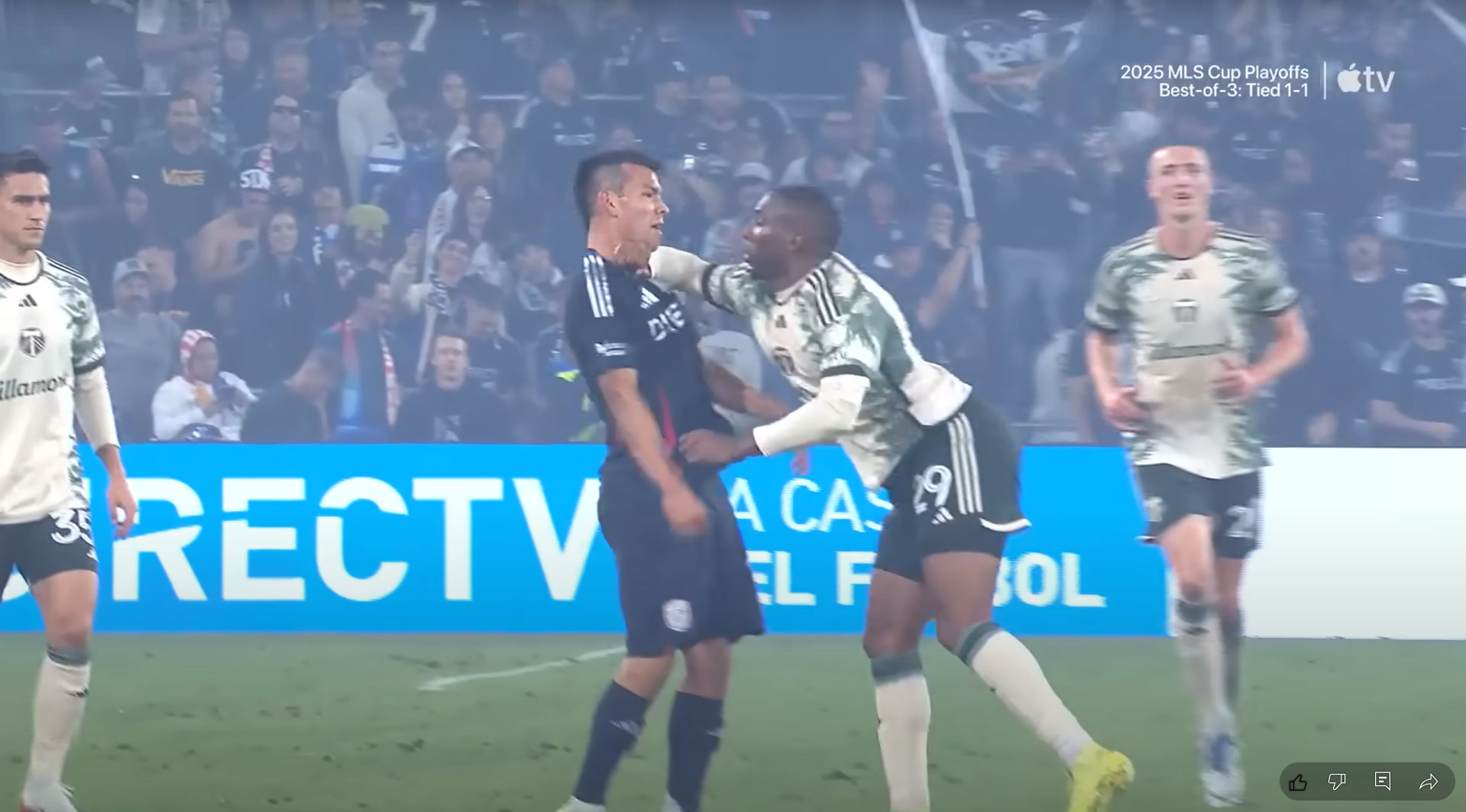
There’s no need for this. But Mosquera does it anyway. It’s an easy red card decision for Dickerson, and Mosquera hits the showers. Mentality though, am I right?
Portland’s season ends with a 4-0 defeat and 10 men on the pitch. Their season began with a 4-1 defeat and 10 men on the pitch. The most frustrating season since 2024 has ended with a whimper.
Out-Of-Possession
Technically, this game was over in the 5th minute. But I’d like to make an argument that it was over from the moment the starting lineup was released.
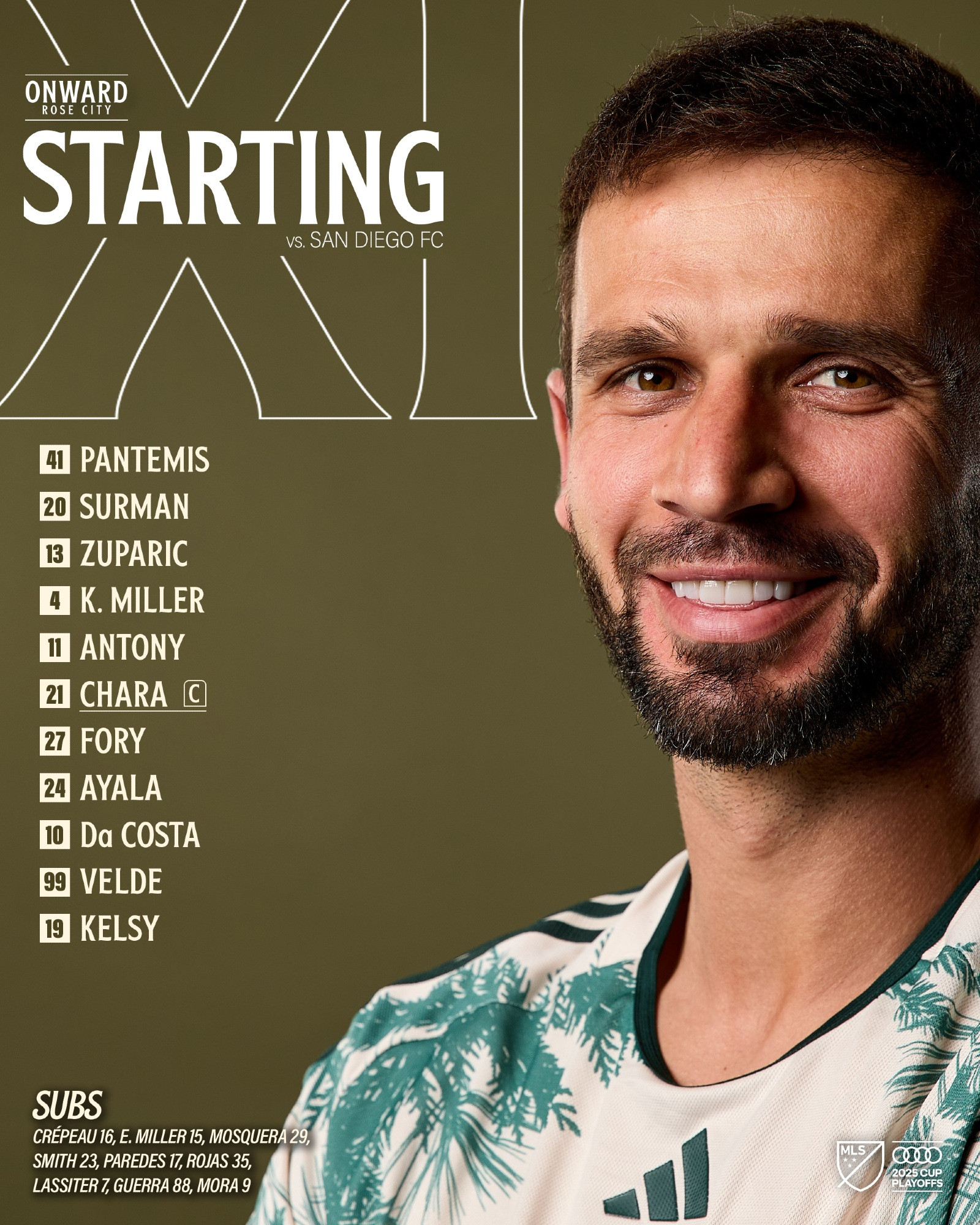
The Portland Timbers did not keep the same shape that they had in Game 2. Their 3-4-3 was back. On Decision Day, the Timbers lined up in a 3-4-3 against San Diego. They lost 4-0. Phil Neville decided to go back to the same structure that provided San Diego with a pathway for humiliation one month ago.
The failure isn’t in the back three. Portland’s back four (when used) functions as a situational back three in possession.

Portland never figured out their best lineup in 2025. The only constants were the players I could actually plug in to this team. Left back could be Kamal Miller or Jimer Fory. Finn Surman’s partner changed based on form. David Ayala had an endless combination of midfield partners. The attack was never settled with a first-choice unit. Injuries played a part, yes, but Portland’s inability to settle on a consistent identity kept them from being competitive when it mattered most.
In a game like tonight’s, with everything on the line, there has to be an “Ol’ Reliable” button. Portland had nothing to fall back on. You’d think that the Game 2 shape (which did a very good job of holding San Diego at bay during the first half) would get another chance. But it didn’t.
I don’t hate Portland’s 3-4-3 shape. I think it has a time and a place to be successful. Portland used it to great effect in their last road win (July 25th at LAFC) and they were very successful in that shape in Vancouver on September 24th. It’s not a bad tactic or structure. It’s a good club to have in the bag. But it is not “Ol’ Reliable” by any means.
Game 2’s shape (a 4-3-3 out of possession) was successful because it provided the Timbers with a proper way to man-mark San Diego. By matching San Diego’s own 4-3-3, only the goalkeeper was left open. That’s fine. With every man successfully marked, the Timbers were able to be in the correct position to win second balls. They were able to force San Diego to go long. That’s due to the extra man in midfield. When the 3-4-3 comes into play, Portland sacrificed their 3rd midfielder for another wingback.
The 3-4-3 needs wingbacks instead of fullbacks. Fory and Antony began the game higher up, which compromised Portland’s ability to defend in transition. This problem was exacerbated when Mosquera entered at halftime. They vacated the middle of the field; an area that they dominated in Game 2. Second balls fell to San Diegan boots. Numerous progressive runs with the ball went unchallenged. The wingbacks were the true failure. It’s like the Timbers looked at everything that made them competitive in Game 2 and decided to forget them. I’d actually take it a step further: active mismanagement. It’s dumbfounding. It’s infuriating. It’s humiliating. The blueprint was there, and it got completely ignored. Easily the most confounding management decision made by the coaching staff during Neville’s tenure.
Don’t take my word for it. After all, the head coach disagrees with my assessment. How about a clip for illustration?
The Timbers are actually lucky. Baird screwing up his first touch probably prevents another San Diego goal.
In the post-game press conference, Neville said that there wasn’t a change to the structure. More on that later. I’d like to disagree.

If it looks like a 3-4-3, and acts like a 3-4-3, it’s probably a 3-4-3! However, it’s not a 3-4-3, because it’s the same tactic that they used in Game 2! No, that doesn’t make sense at all. Mostly because it’s completely wrong.
San Diego’s midfielders continued to drop deep to pick up the ball, but no one followed them due to the lack of a true man-to-man marker. Those midfielders were blanketed every time they dropped deep in Game 2. In Game 3, they had all the time in the world.
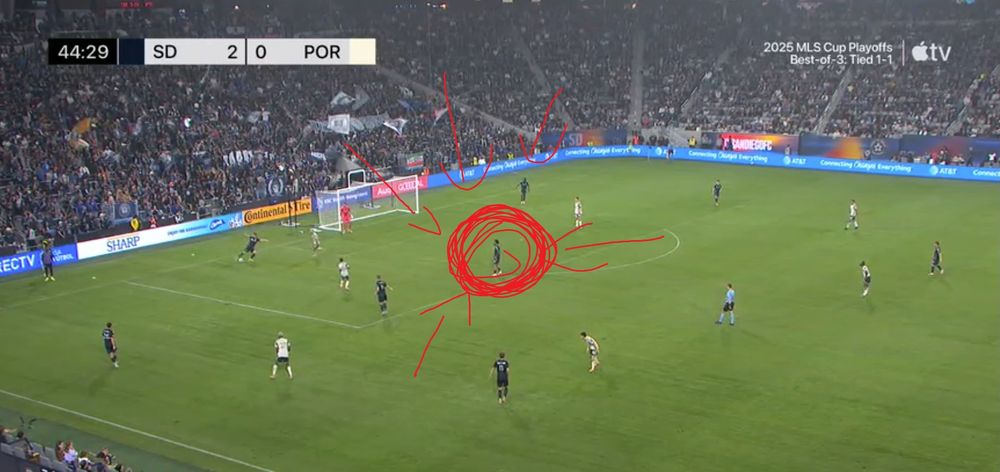
That helpful red circle is around Anibal Godoy. He’s standing in the middle of the field, which is an area that you want to cover. Don’t worry, that obnoxiously large red circle is not blocking any Portland players. None of them are around him. He has no marker. But there is a clear first line of three and a second line of four. A tangible shape can be observed. Unfortunately, it’s too easy to play through. This was known prior to this game, and yet it was how the Timbers set up.
Dreyer kept dropping deep as well, which would pull Miller into the attacking third. I don’t have a huge issue with that on the surface. Technically, Miller is marking his man. Dreyer did the same thing in Game 2. HOWEVER, because the wingbacks were already high, it left tons of space in behind. In Portland’s 2-1 defeat at St. Louis on July 13th, Miller was tasked with man-marking Joao Klauss. This left gaps of space in behind as well, particularly when Klauss would drop into the midfield. Klauss rarely got the ball in these scenarios. It was purely a maneuver to open space. Likewise, Dreyer would get the ball in the midfield during this game, but he’d quickly move it. It was another maneuver to open space.
I don’t think Mikey Varas made significant changes to the way that San Diego plays for this game. After watching this team for a month straight, I noticed Dreyer dropping more often than usual. I think that was an in-game adjustment because Neville’s decision to change the structure made it easier to manipulate Portland’s left side. Both first half goals were scored on that left side. Coincidence?
This change in shape combined with the (correct) decision to keep the principle of an aggressive man-to-man press doomed the Timbers. After Game 2, I thought I’d never have to write about the out-of-possession structure in a negative light ever again. It seemed solved. It appeared to be a blueprint for future success. And it lasted a total of one week. Words can’t describe how much of a blunder this is. If you told me that there was one basic change that the team could make and ultimately cost them this game, it would’ve been a shape change. Such a mindless decision. One that could only harm the team. And that’s exactly what it did.
Player Ratings
James Pantemis: 6
Pantemis completed 13% of his long balls in this game. I don’t think that’s a terrible number, but the Timbers suffered because they were unable to win the second balls generated from those launches. Brutal. I don’t blame him for failing to save any of San Diego’s goals. The structure let him down tonight.
Finn Surman: 8
Garbage time became a Finn Surman clinic as he routinely tracked down breakaway runners and made key clearances. On the broadcast, Maurice Edu said that this game could’ve been “5 or 6 or 7 to nothing” if it wasn’t for Surman’s outstanding defending. Does the Godfather offer arrive in the winter or next summer?
Dario Zuparic: 6
Zuparic was definitely there. He was on the field. Was he good? Not really. Was he forced to constantly keep tracking back to defend direct attacks. Yep.
Kamal Miller: 7
I didn’t think Miller covered himself in glory, but it was a relatively solid outing. He had a couple of good moments in 1v1 duels, particularly a 48th-minute sequence against Dreyer. Technically, he wasn’t a far post defender. That’s what wingbacks are for!
Antony: 7.3
I’ve never understood the idea that Antony can’t play on the right. His deliveries from that side of the pitch were outstanding in this game. He didn’t have to do much back post defending either, but he was making the recovery runs.
Diego Chara: 8.5
Left at a numerical disadvantage, the club captain tried his hardest to tilt the field Portland’s way. Several excellent individual plays highlighted another great Chara performance. I don’t think that’s his last game in a Timbers shirt, but that’s his decision to make.
David Ayala: 7
The tackle on Tverskov to set up Kelsy’s chance was superb. For the remainder of the night, he was chasing shadows.
Jimer Fory: 5.5
This might seem harsh. He did make the recovery runs to at least try and stop both of San Diego’s first half goals. But he did have a couple chances in the first half. The first was unlucky (kept out by Sisniega’s knee) and the second was disappointing.
But the key part of this grade comes from his yellow card. You’d think that he’d be a little bit more cautious after his Game 1 dismissal, but he made a poor attempt at a tackle and paid the price. That yellow is why he got subbed off at halftime.
David Da Costa: 6.2
Portuguese Dave received the ball in open space quite a bit in this game, but he rarely tried any line-breaking passes and often settled for cross-field switches instead. Timbers players weren’t willing to make off-ball runs. That’s a common theme. I thought he did an OK job at progressing the ball, but the cutting edge in the final third was missing.
Kristoffer Velde: 6
San Diego wanted to erase Velde from this game. So they did. He only touched the ball 38 times, and was pretty invisible in the first half. The second half was slightly better, but it was garbage time.
Kevin Kelsy: 5.8
The 11th minute chance is a huge miss. There’s no denying that. But I’d like to turn your attention to the first three minutes of this game, when Kelsy committed two needless fouls.
Kelsy has all the tools to be a good striker. In this game, he received the most service he’s had all season. He’s still learning how to properly lead the line, but some of those chances needed to find the back of the net. Actually, scratch that. The 27th-minute header needed to be on target. None of those chances (aside from the 11th minute) could qualify as “big” but they still needed to challenge the goalkeeper.
Juan Mosquera: 2
This rating has a double meaning! It stands for the number of chances he created and the number of goals he allowed at the back post.
Prior to kickoff, the Apple broadcast noted that Mosquera was dealing with a “tendon” injury. This led to him being scratched from the starting lineup and entering at halftime. Did he look unfit? Kind of. He’s made significant strides to his back post defending this year, but it was nonexistent tonight. Maybe bringing on a player gutting through injury to play a physically demanding role might be a bad idea. However, Riqui Puig assisted the game-winning goal in last year’s Western Conference Final on a torn ACL. Maybe mentality is an issue?
Mosquera’s red card was completely avoidable. Pretty easy to make that call. However, Mosquera is very active on Instagram. I wonder what he was doing after the game?

Come on, man. That’s the goal you gave up because you didn’t make a recovery run to the back post.
Mosquera will be suspended for the first game of next season. He’s a player that usually rises to the occasion in big games. Tonight, he had the biggest disasterclass I’ve seen from a Timbers player in a playoff game.
Cristhian Paredes: 6
Paredes entered this game with a clear edge. I’ve never seen him play that angry before. One of Mosquera’s 2 created chances found Paredes’ head in the box, but the resulting header hit the crossbar. At least he showed some passion.
Mati Rojas: 6
Rojas took one shot in this game. It was from the halfway line in the 73rd minute, and it flew over the goal. At least he tried. After entering, he played as an attacking midfielder in the 10 role. I don’t think he was especially bright.
Felipe Mora: 6
Mora was pretty anonymous in this game, but he did his job defensively. Was that his last appearance in a Timbers uniform?
Gage Guerra: 6.5
Guerra entered as a second striker in the 75th minute. Five minutes later, Mosquera was sent off. He played right back for the remainder of the game.
Coach Rating: 1
I already talked about the gameplan in a previous section. Now it’s time to look at the post-game justification of the gameplan.
“We picked players that were 100% fit. We rewarded the players that played in the game on Saturday.”
Mosquera not being fit and not starting him is understandable. But a case could be made to use Antony as a right back in the Mosquera role. I would’ve done it to keep the Game 2 structure intact.
That was the answer to Guillermo Motta’s question about the starting lineup selection. It was a good question, but it didn’t answer the main issue I had with Portland’s XI. I was more concerned about the shape than I was about personnel. Since I was up next, I decided to ask about it.
“Hi coach, uh, kinda building off that starting lineup question. What was the idea from switching from 3 men in the midfield to 2 men in the midfield and putting 2 wingbacks higher up the pitch?”
This is the most important question as it relates to yesterday’s game. The decision to vacate the midfield effectively handed San Diego a “get-out-of-jail-free” card for Portland’s press. Here’s the answer.
“Well, we played 3 in midfield, just like we did on Saturday and we played with 2 men higher up the pitch just like we did on Saturday.”
Reminder: this is what the Timbers looked like tonight.
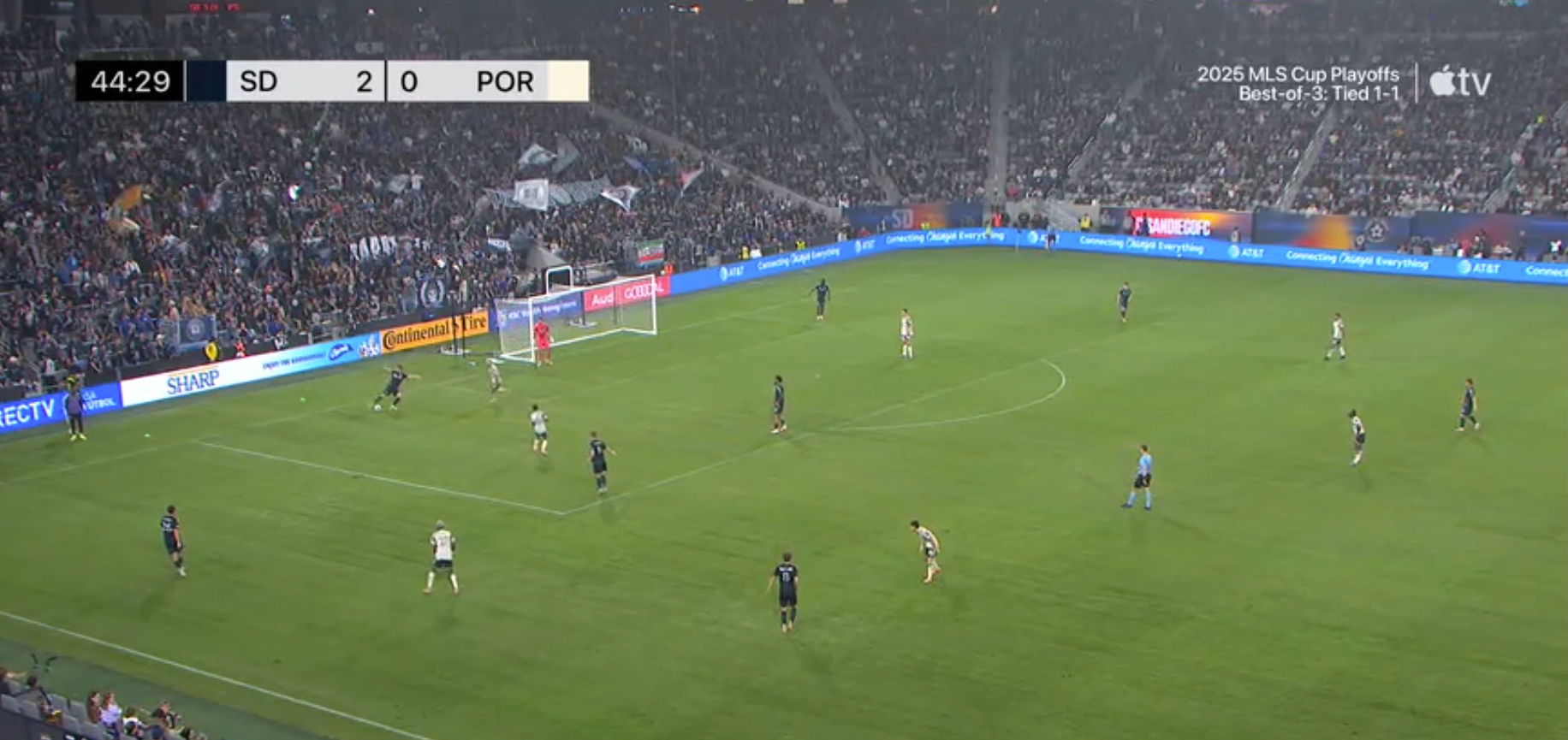
The camera angles will be different on this next screenshot, but that’s not the only major difference.
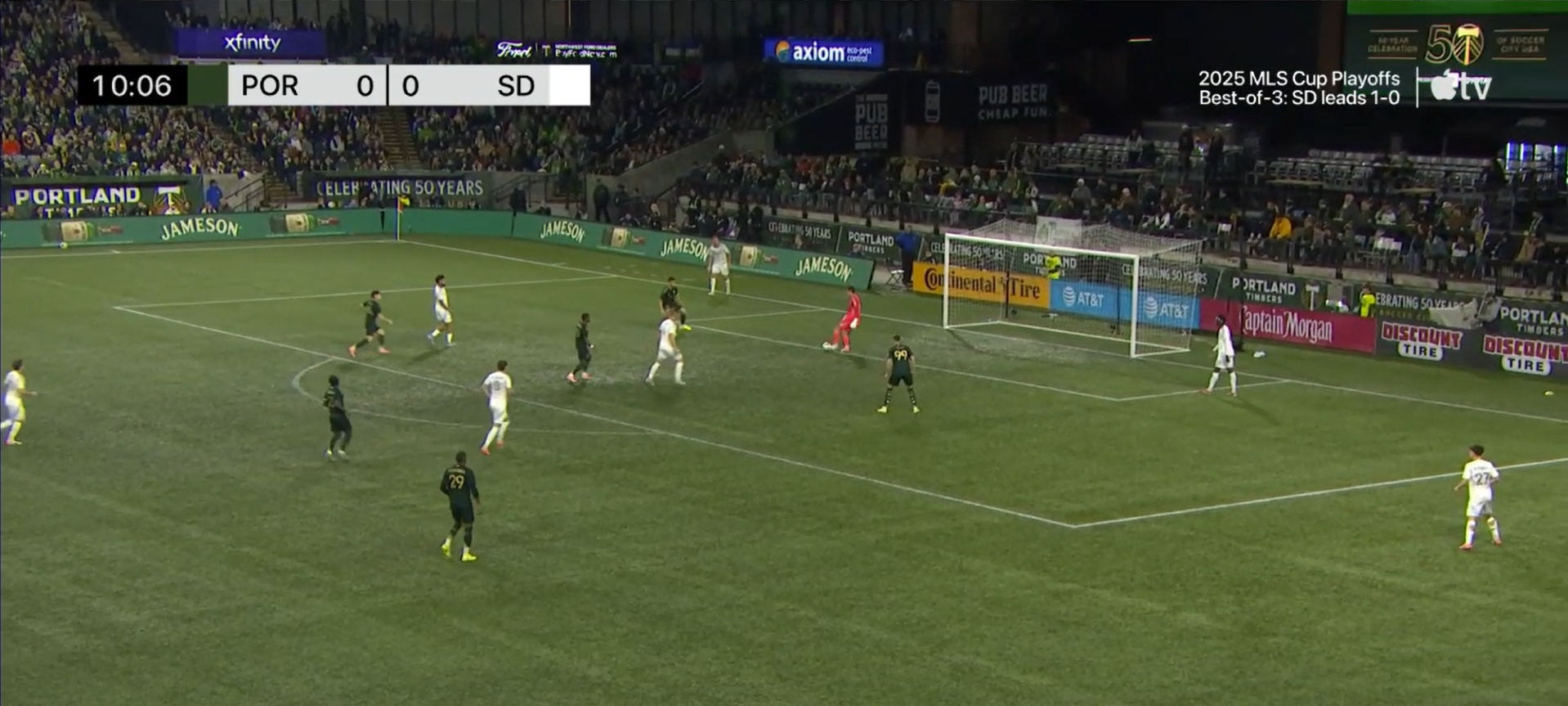
Every player in this Game 2 image is marked. In Game 3, the center of the pitch is wide open. Mosquera is marking Bombino at the bottom of the image. Miller is marking Dreyer, who is just coming into the picture. Portland is not outnumbered around San Diego’s box.
That’s because the midfielders are pushed into the final third. In Game 3, the two midfielders (because there are two midfielders in Game 3, not three midfielders) are on the edge of the middle third. Portland did not have three midfielders in Game 3. They had two.
Mosquera is higher on the right in Game 2, but he’s marking a man. Portland’s left back in Game 2 (Miller) is marking Dreyer. Portland does not have two wingbacks holding the width on the flanks in Game 2. They did in Game 3.
“To be honest with you, there might have been a graphic that went out at the weekend that showed us in a 4-3-3 but we didn’t. We played the same system.”
“System” is not the word I’d use. I think the Timbers kept the same (correct) principles from Game 2. But the structure is the issue. There was a defined 4-3-3 shape out of possession in Game 2. That same shape was not present in Game 3. It’s not the same structure.
“We had Chara, we had Da Costa, and we had Ayala in midfield tonight.”
Da Costa was positioned higher up than Ayala in the midfield, but Ayala and Da Costa would often switch places in the press. When the Timbers had the ball, Da Costa would come deep to receive and progress it. I can see the logic to this answer in possession, but it’s not the same out-of-possession.
“I just said to them in there, it wasn’t probably about a system or a tactic, it was more about the mentality. They didn’t beat us in football, they beat us because they wanted it more. They run more, and that’s on me. I take responsibility for that, and we need to be better.”
The Timbers did a lot of running tonight. Most of it was done during recovery runs after San Diego easily bypassed Portland’s press. They got beat on football. They got beat because San Diego was able to progress the ball at will. Could there be some mentality questions? Probably. But going into those problems misses the main issue. The Timbers were not set up to win this game. They were set up to allow San Diego to routinely attack their backline.
Portland could have a blueprint for next season’s identity. Game 2 was a potential turning point. Their players were in the best position to succeed, and they did. It took them a while to do so, but even a loss on penalties would not have changed my perspective on that performance. I don’t understand how the immediate thought process was “change it” for the next game. They gave San Diego the platform to succeed. No subs could have changed that. It was over after 20 minutes.
"Mentality" is not the reason why the Timbers lost this game. I didn't notice lack of effort on the field. I saw a team that was chasing shadows all game because their head coach did not put them into the best position to succeed.
Bracket Time

The Conference Semifinal matchups have been set. NYCFC is the only lower seed to advance from the first round. The top four teams in the West have been the clear top four all year. The East had an opportunity for chaos, but it appears that no chaos actually emerged aside from a couple of Game 3s.
Final Whistle
The Thorns took care of business on Sunday morning. They needed extra time, but they’re through to the semifinals. A trip to Washington is on the cards for next week.
I had receipts ready for this game. If the Timbers won, I would’ve had a field day with San Diego’s nonsense. From their AI graphics to a cringe-worthy song posted by their social media team, I was looking forward to dunking on a fanbase I don’t respect. But I was also fired up by one quote in particular.
MLS writer Charles Boehm published a good piece featuring an interview with San Diego general manager Tyler Heaps on Friday. In this article, Heaps said something that really bugged me.

The Timbers have spent the entire season trying to be better in possession. They want to control the ball and dictate play. Unfortunately, they weren’t very good at it, so they decided to focus on the press after losing Game 1. It was the correct move. That quote angered me not from Heaps’ assessment of the Timbers, but his own correct assessment of his own first-year expansion squad.
San Diego is exactly what Heaps says that they are. A team that didn’t play a single game in their history before February has found the blueprint for consistent, winning soccer. It took them one year to build their squad. Now they’re cruising into the Conference Semifinals with a serious chance of winning MLS Cup. That’s what creating a sustainable identity can do. It establishes a floor. Depending on how good the players and coach are, that floor can be raised.
The Timbers do not have that base level. Neville’s first two seasons have been filled with consistent inconsistency. The main task in 2025 was to find a winning identity. For one brief moment, it looked like they had one. Only for it to get flushed down the drain one week later. They got embarrassed by an expansion team that had everything figured out from day one. DAY ONE! Portland hasn't been able to figure out who they are since Neville got the job in November 2023.
2024's team would get knocked down, but they got back up again. After a significant roster turnover in the winter, Portland's 2025 looked like a semi-rebuilding year. But a rebuild would technically be step back, so they took the smallest step forward in 2025. And they did it while having a floor that moved on a game-by-game basis.
The 2025 MLS season has been dictated by brand-new coaches raising the floor of their new clubs. Varas’ exploits in San Diego would normally result in a Coach of the Year trophy, but the achievements of Jesper Sorensen’s Vancouver and Bradley Carnell’s Philadelphia teams made it a surprising three-horse race. BJ Callaghan’s Nashville could also fall into this category, but he took the reins in the middle of 2024.
Year two of Neville’s tenure has seen the team fail to find a consistent floor for the second year in a row. Despite some bad injury luck at the top of the roster (Jonathan Rodriguez and Felipe Carballo) there is a direct comparison to teams like Vancouver, who were shattered by injuries during the majority of this season. But the Whitecaps’ extremely high floor kept them from slipping.
Neville’s consistent reminders about “mentality” can only go so far. This isn’t the MLS of the mid-2010s anymore. Sophisticated tactical setups are found from Vancouver to San Diego to New York and Columbus. Mentality can provide the ceiling. But a strong tactical setup is the floor. Neville has to learn that in this offseason. It could cost him a second contract, or worse. When a team is consistently beatable, like all versions of Neville's Portland teams, the margin for error is significantly lowered. Many could point to Kelsy's missed chance as the moment that the Timbers needed to have. That chance, however significant, is irrelevant in the big picture. Even if Kelsy scores, San Diego's effortless direct attacks would have continued. That's not sustainable. Finding sustainable methods for success is what the Timbers desperately need. That can be accomplished through a multitude of different identities. The principles of this team need to be evident. Right now, they're principally broken.
However, the Portland Timbers do have an identity. Their entire team will go as far as luck can take them. Ten years ago, this club won its only MLS Cup title. The event that propelled them on that run was the luckiest of them all: a double-posted penalty kick. Luck can provide the magic necessary for a cup run. But the ship cannot be powered by luck alone.
Since that fateful day in December 2021, the Timbers and their fans have been consistently humiliated. From the Yates Report and the bludgeoning that occurred a week later in 2022 to the capitulation to Houston at home in 2023, the Timbers have been embarking on a decade of humiliation. A team that rose to prominence in the 2010s has spent the 2020s accepting mediocrity and failure in the biggest moments. The Portland Timbers can be a big club again. They simply aren’t right now.
Year 50 has been a tale about security. Portland effectively secured their playoff spot in April. Since that time, they faded but their playoff security was never in doubt. On Decision Day, they fell into the Wild Card. That’s still a playoff spot. Despite a couple of memorable moments, this season is notable for being Year 50. Paul’s promise still stands. The Timbers are still here. But they have to learn how to climb again. They’ve done a good job of settling. Will they settle for the consistent humiliations that have occurred year after year?
Year 3 of Neville’s tenure has officially begun. It’s the final year of his 3-year contract. The first two have been defined by inconsistency on the field. From this vantage point, Year 3 will be another mixed bag. Is 2026 the year where the humiliations finally end? Will their 2026 campaign end in a respectable fashion for the first time since 2018? 10 years have passed since Portland’s last trophy. They aren’t at laughingstock status yet, but they’re awfully close.
If you want to talk about technicalities, the Timbers did make progress in 2025. Getting blown out in the First Round is one step above getting blown out in the Wild Card.
The future is cloudy. Decisions will have to be made regarding key players and more. For the fourth straight offseason, the taste of another season-ending blowout will remain until games start again in 2026. It can’t keep ending like this. It just can’t. The voyage is over. The humiliations continue.
Programming Notes
It has been a long season here at Cascadia FC, and I’d like to thank everybody for making our transition to Ghost a success. Michael Martinez deserves the most thanks for doing all the technical work behind the website. Callaghan Bluechel has been putting in the hard work with the Sounders and the Reign this year. Adeeb Shir and Alex Bowen have been welcome additions in Vancouver. Lily Crane and Brooke Neiman are outstanding with their Thorns coverage. Leroy Freeman’s photography work in Seattle has been excellent. Guest writer Owen Murray’s contributions have always been welcome. Big things are coming in 2026, so stay tuned for more offseason content from everybody!
This has been a difficult year for me as I’ve worked to balance a new job schedule with my usual duties covering the team. As always, doing this is still a dream come true. Year 3 with Cascadia brought me to familiar spots like Seattle and Salt Lake City, but my horizons were expanded with trips to Austin/Dallas and Los Angeles. I’m looking forward to what Year 4 will bring, and I have to thank all of y’all for making it possible. First offseason mailbag coming in about a week-and-a-half. I need to let this season settle a little more first. As always, thank you and onwards.


